Training and Development Evaluation at Tesco
VerifiedAdded on 2020/02/17
|22
|4465
|125
AI Summary
This assignment focuses on evaluating Tesco's training and development programs. It requires an analysis of various aspects including training content, delivery methods, trainer enthusiasm, mentor effectiveness, and overall program success based on participant feedback. The evaluation should also assess the impact of the training on skill enhancement for future development.
Contribute Materials
Your contribution can guide someone’s learning journey. Share your
documents today.

Human Resource Development
Secure Best Marks with AI Grader
Need help grading? Try our AI Grader for instant feedback on your assignments.
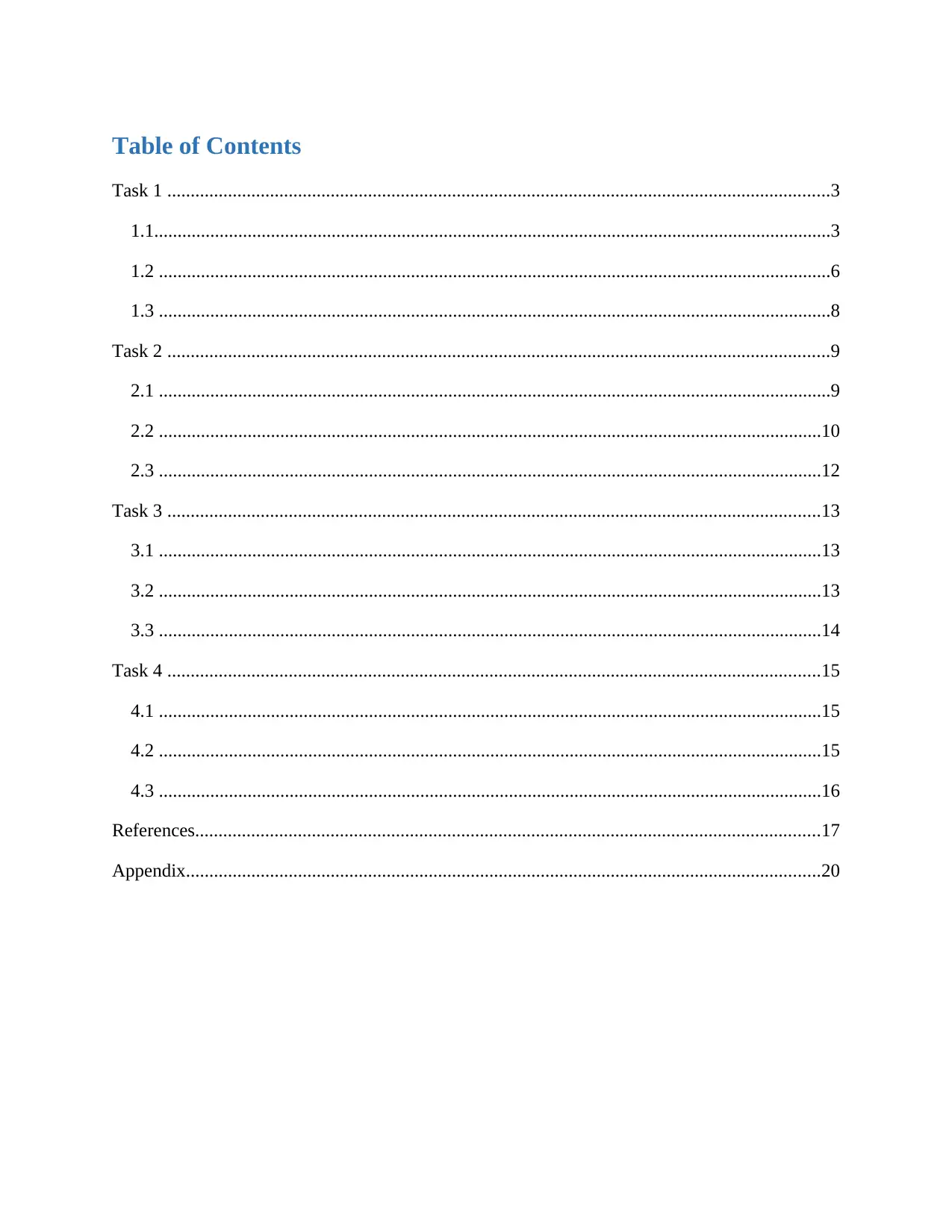
Table of Contents
Task 1 ..............................................................................................................................................3
1.1.................................................................................................................................................3
1.2 ................................................................................................................................................6
1.3 ................................................................................................................................................8
Task 2 ..............................................................................................................................................9
2.1 ................................................................................................................................................9
2.2 ..............................................................................................................................................10
2.3 ..............................................................................................................................................12
Task 3 ............................................................................................................................................13
3.1 ..............................................................................................................................................13
3.2 ..............................................................................................................................................13
3.3 ..............................................................................................................................................14
Task 4 ............................................................................................................................................15
4.1 ..............................................................................................................................................15
4.2 ..............................................................................................................................................15
4.3 ..............................................................................................................................................16
References......................................................................................................................................17
Appendix........................................................................................................................................20
Task 1 ..............................................................................................................................................3
1.1.................................................................................................................................................3
1.2 ................................................................................................................................................6
1.3 ................................................................................................................................................8
Task 2 ..............................................................................................................................................9
2.1 ................................................................................................................................................9
2.2 ..............................................................................................................................................10
2.3 ..............................................................................................................................................12
Task 3 ............................................................................................................................................13
3.1 ..............................................................................................................................................13
3.2 ..............................................................................................................................................13
3.3 ..............................................................................................................................................14
Task 4 ............................................................................................................................................15
4.1 ..............................................................................................................................................15
4.2 ..............................................................................................................................................15
4.3 ..............................................................................................................................................16
References......................................................................................................................................17
Appendix........................................................................................................................................20
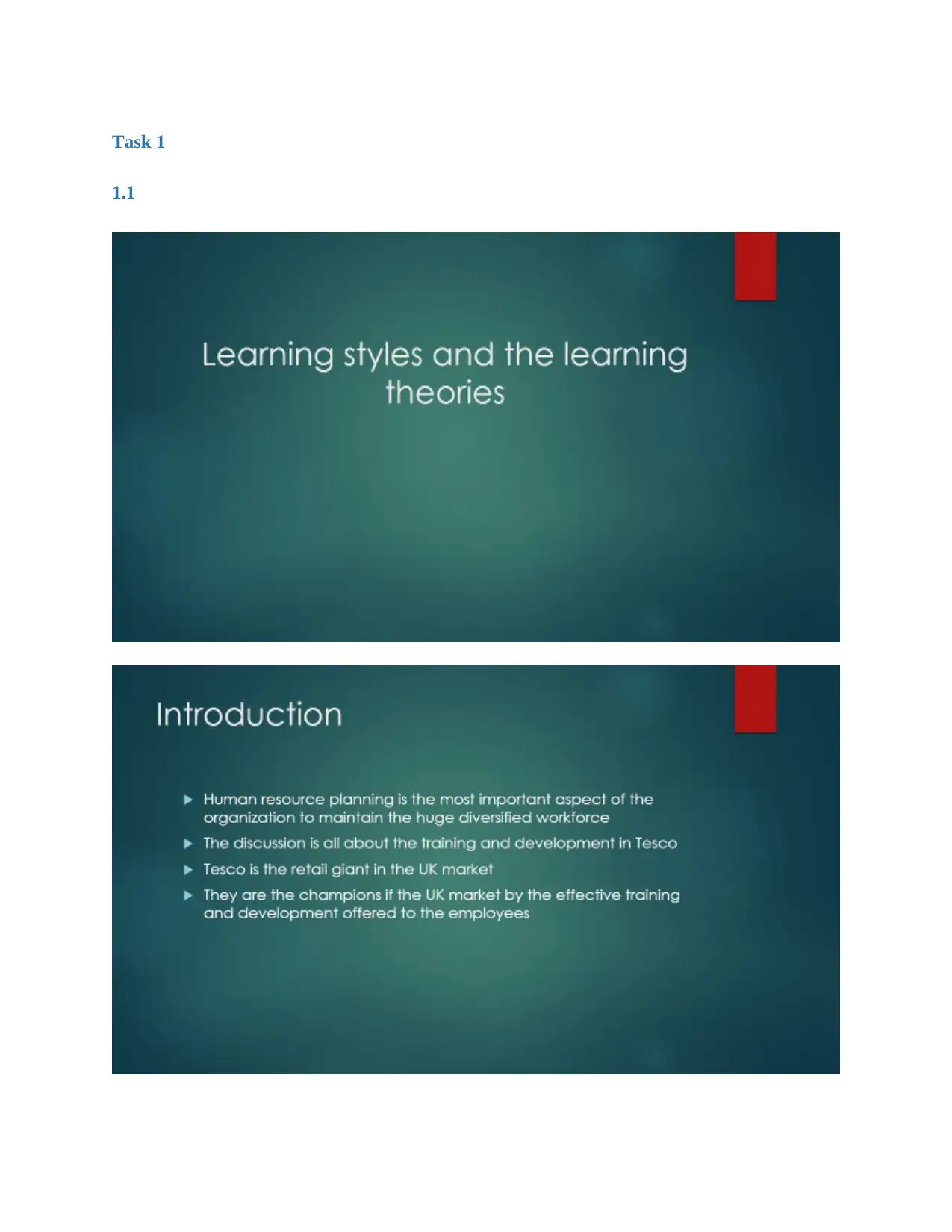
Task 1
1.1
1.1
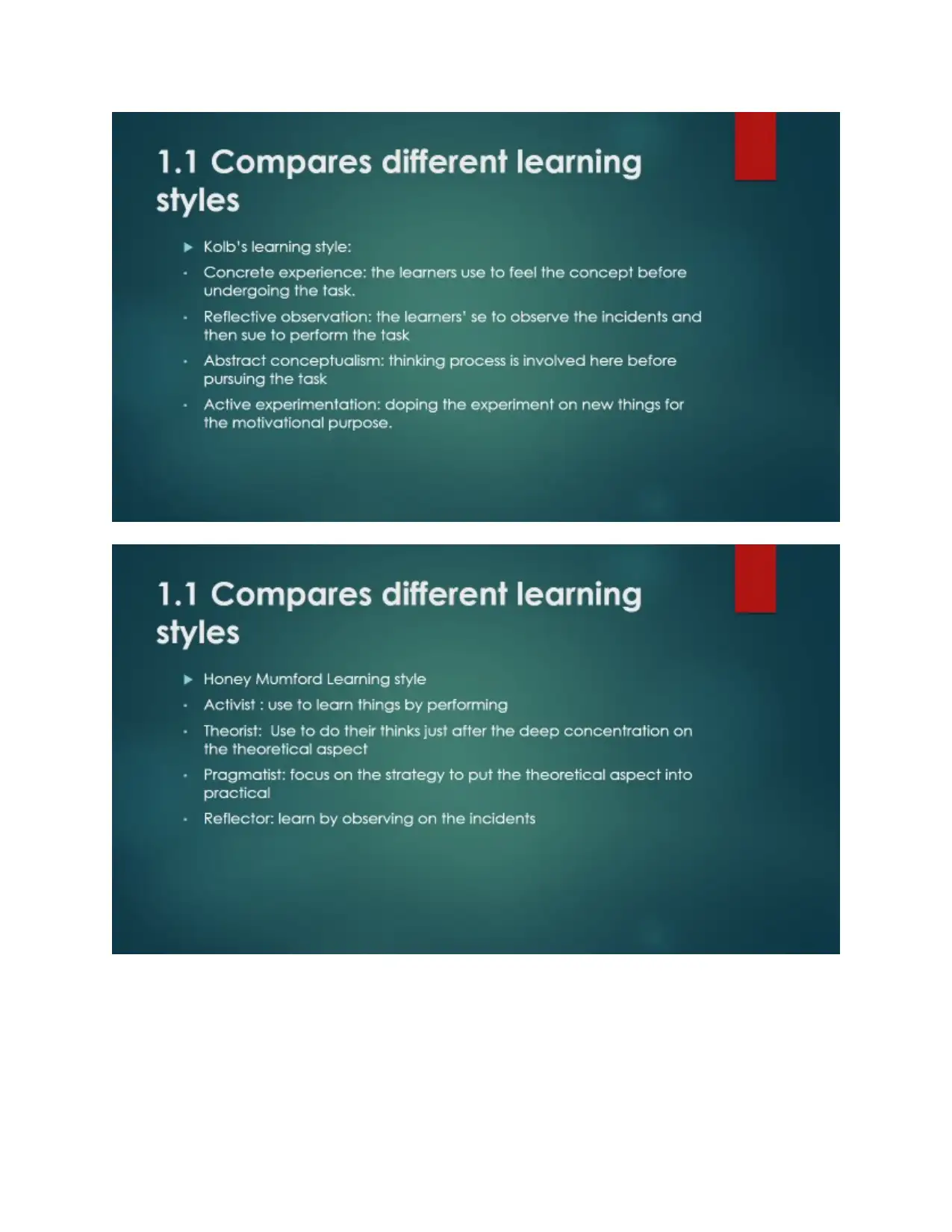
Secure Best Marks with AI Grader
Need help grading? Try our AI Grader for instant feedback on your assignments.
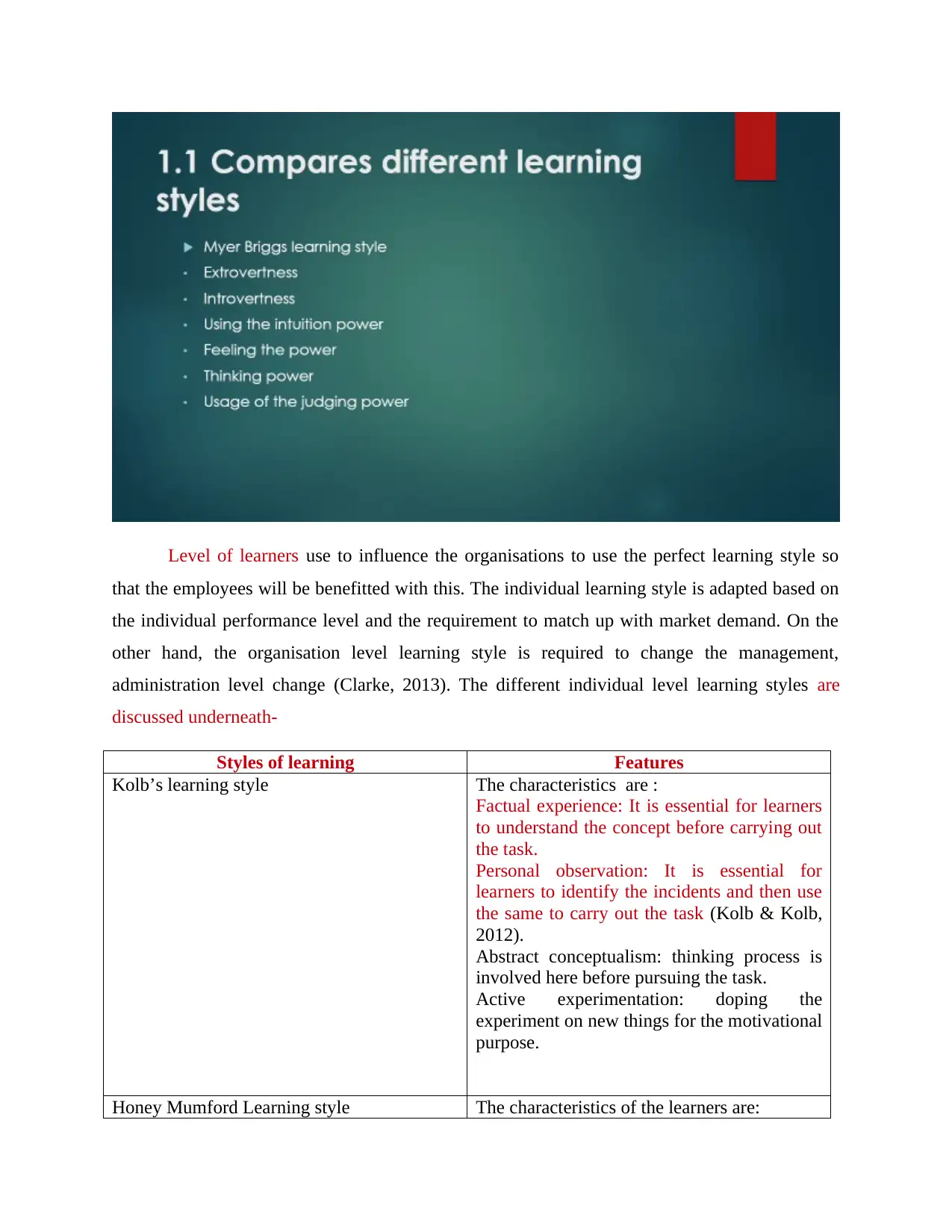
Level of learners use to influence the organisations to use the perfect learning style so
that the employees will be benefitted with this. The individual learning style is adapted based on
the individual performance level and the requirement to match up with market demand. On the
other hand, the organisation level learning style is required to change the management,
administration level change (Clarke, 2013). The different individual level learning styles are
discussed underneath-
Styles of learning Features
Kolb’s learning style The characteristics are :
Factual experience: It is essential for learners
to understand the concept before carrying out
the task.
Personal observation: It is essential for
learners to identify the incidents and then use
the same to carry out the task (Kolb & Kolb,
2012).
Abstract conceptualism: thinking process is
involved here before pursuing the task.
Active experimentation: doping the
experiment on new things for the motivational
purpose.
Honey Mumford Learning style The characteristics of the learners are:
that the employees will be benefitted with this. The individual learning style is adapted based on
the individual performance level and the requirement to match up with market demand. On the
other hand, the organisation level learning style is required to change the management,
administration level change (Clarke, 2013). The different individual level learning styles are
discussed underneath-
Styles of learning Features
Kolb’s learning style The characteristics are :
Factual experience: It is essential for learners
to understand the concept before carrying out
the task.
Personal observation: It is essential for
learners to identify the incidents and then use
the same to carry out the task (Kolb & Kolb,
2012).
Abstract conceptualism: thinking process is
involved here before pursuing the task.
Active experimentation: doping the
experiment on new things for the motivational
purpose.
Honey Mumford Learning style The characteristics of the learners are:
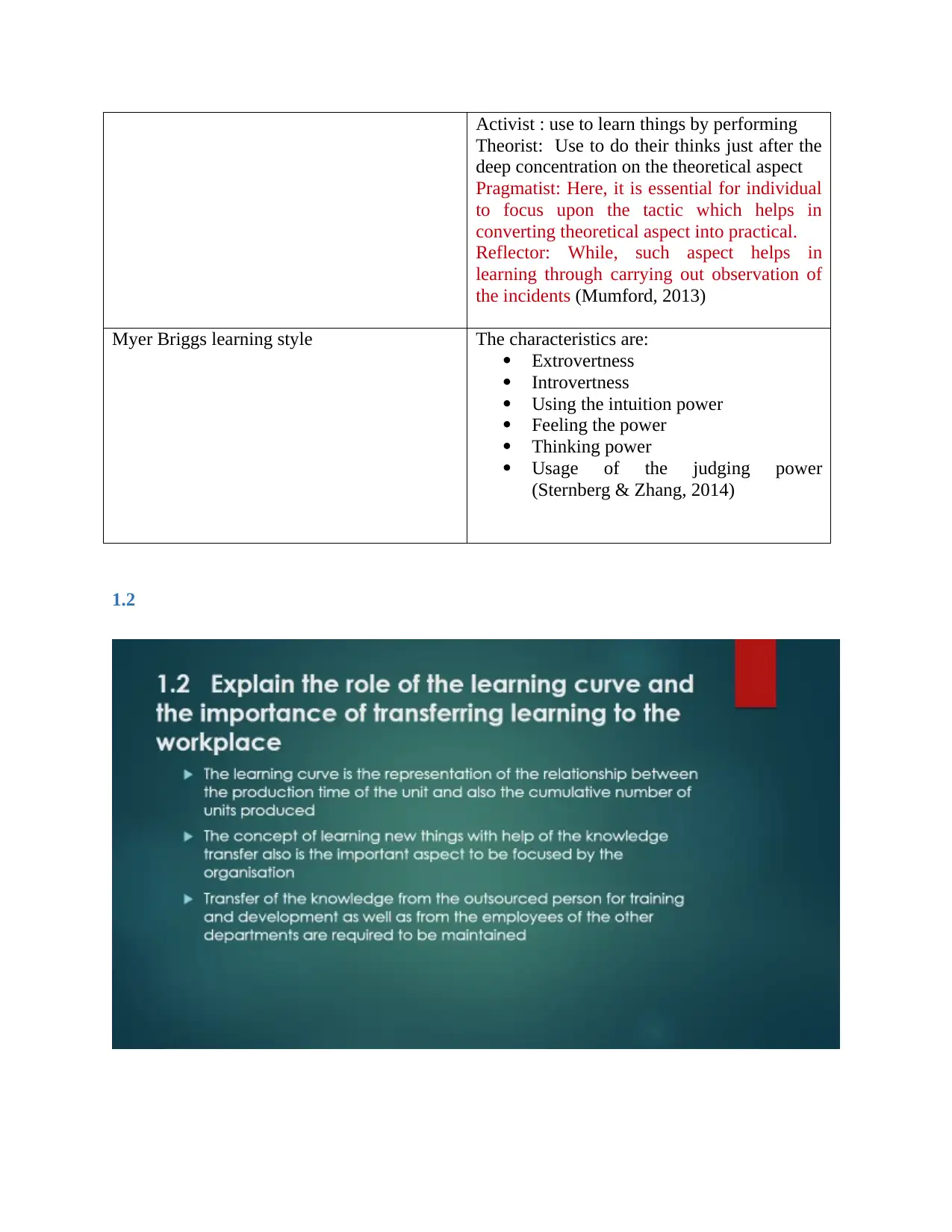
Activist : use to learn things by performing
Theorist: Use to do their thinks just after the
deep concentration on the theoretical aspect
Pragmatist: Here, it is essential for individual
to focus upon the tactic which helps in
converting theoretical aspect into practical.
Reflector: While, such aspect helps in
learning through carrying out observation of
the incidents (Mumford, 2013)
Myer Briggs learning style The characteristics are:
Extrovertness
Introvertness
Using the intuition power
Feeling the power
Thinking power
Usage of the judging power
(Sternberg & Zhang, 2014)
1.2
Theorist: Use to do their thinks just after the
deep concentration on the theoretical aspect
Pragmatist: Here, it is essential for individual
to focus upon the tactic which helps in
converting theoretical aspect into practical.
Reflector: While, such aspect helps in
learning through carrying out observation of
the incidents (Mumford, 2013)
Myer Briggs learning style The characteristics are:
Extrovertness
Introvertness
Using the intuition power
Feeling the power
Thinking power
Usage of the judging power
(Sternberg & Zhang, 2014)
1.2
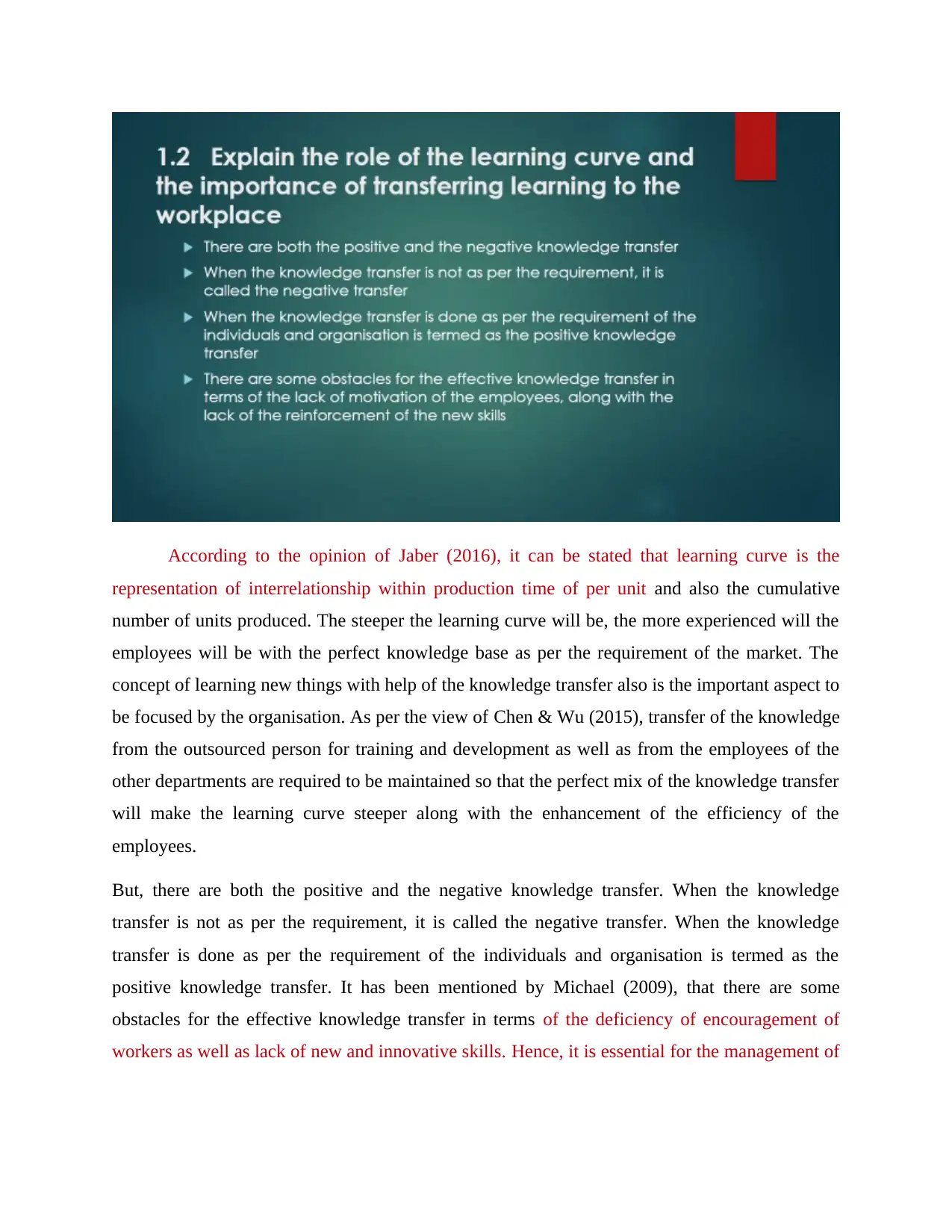
According to the opinion of Jaber (2016), it can be stated that learning curve is the
representation of interrelationship within production time of per unit and also the cumulative
number of units produced. The steeper the learning curve will be, the more experienced will the
employees will be with the perfect knowledge base as per the requirement of the market. The
concept of learning new things with help of the knowledge transfer also is the important aspect to
be focused by the organisation. As per the view of Chen & Wu (2015), transfer of the knowledge
from the outsourced person for training and development as well as from the employees of the
other departments are required to be maintained so that the perfect mix of the knowledge transfer
will make the learning curve steeper along with the enhancement of the efficiency of the
employees.
But, there are both the positive and the negative knowledge transfer. When the knowledge
transfer is not as per the requirement, it is called the negative transfer. When the knowledge
transfer is done as per the requirement of the individuals and organisation is termed as the
positive knowledge transfer. It has been mentioned by Michael (2009), that there are some
obstacles for the effective knowledge transfer in terms of the deficiency of encouragement of
workers as well as lack of new and innovative skills. Hence, it is essential for the management of
representation of interrelationship within production time of per unit and also the cumulative
number of units produced. The steeper the learning curve will be, the more experienced will the
employees will be with the perfect knowledge base as per the requirement of the market. The
concept of learning new things with help of the knowledge transfer also is the important aspect to
be focused by the organisation. As per the view of Chen & Wu (2015), transfer of the knowledge
from the outsourced person for training and development as well as from the employees of the
other departments are required to be maintained so that the perfect mix of the knowledge transfer
will make the learning curve steeper along with the enhancement of the efficiency of the
employees.
But, there are both the positive and the negative knowledge transfer. When the knowledge
transfer is not as per the requirement, it is called the negative transfer. When the knowledge
transfer is done as per the requirement of the individuals and organisation is termed as the
positive knowledge transfer. It has been mentioned by Michael (2009), that there are some
obstacles for the effective knowledge transfer in terms of the deficiency of encouragement of
workers as well as lack of new and innovative skills. Hence, it is essential for the management of
Paraphrase This Document
Need a fresh take? Get an instant paraphrase of this document with our AI Paraphraser
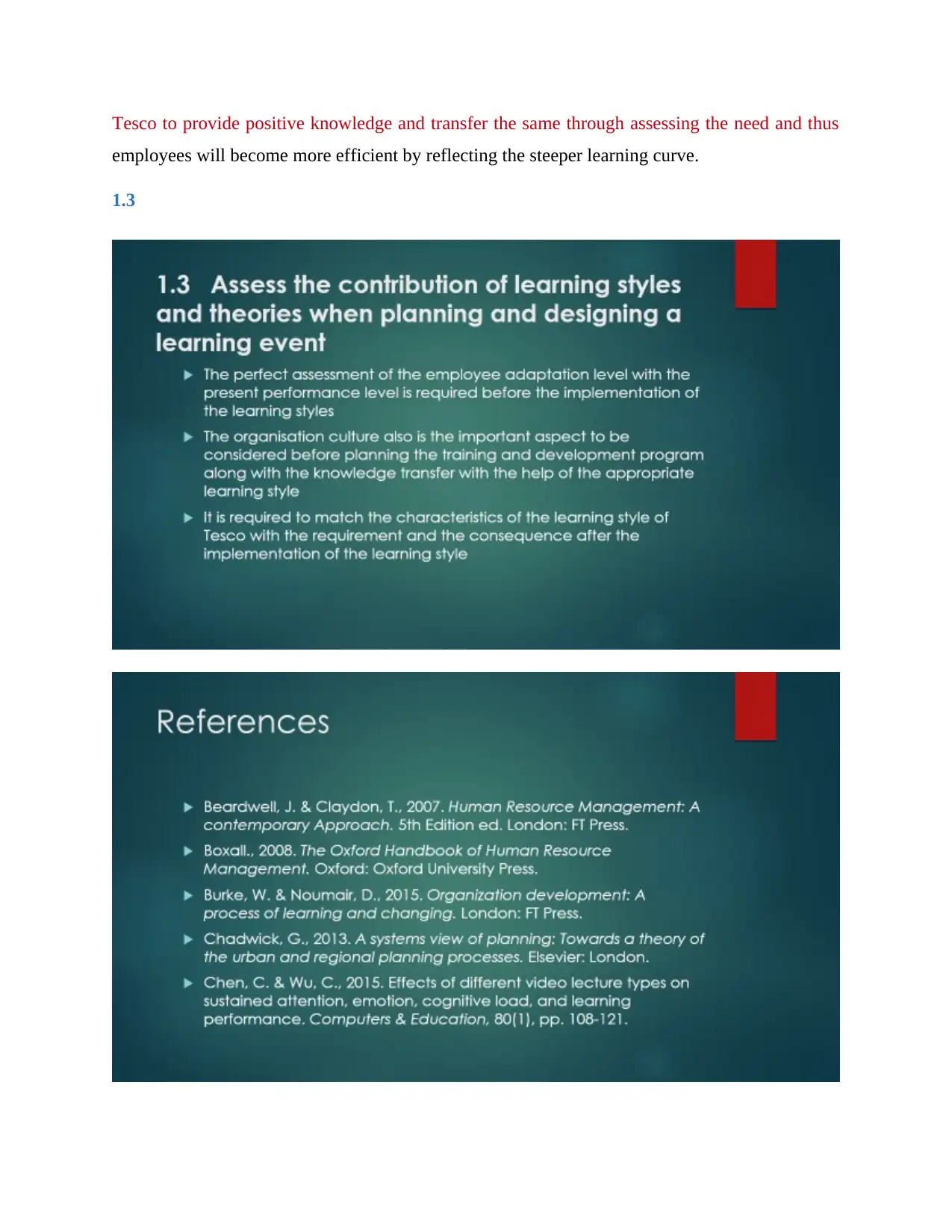
Tesco to provide positive knowledge and transfer the same through assessing the need and thus
employees will become more efficient by reflecting the steeper learning curve.
1.3
employees will become more efficient by reflecting the steeper learning curve.
1.3
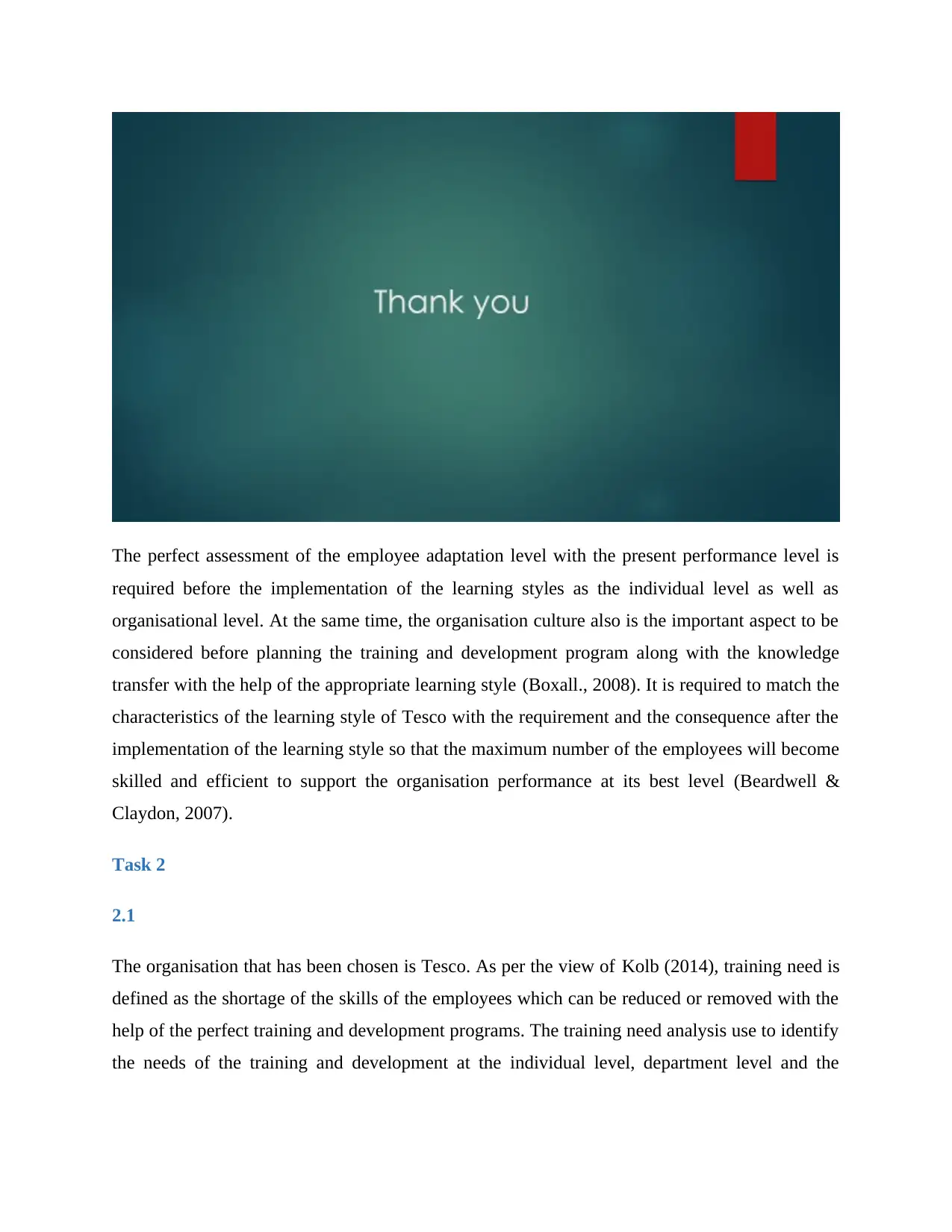
The perfect assessment of the employee adaptation level with the present performance level is
required before the implementation of the learning styles as the individual level as well as
organisational level. At the same time, the organisation culture also is the important aspect to be
considered before planning the training and development program along with the knowledge
transfer with the help of the appropriate learning style (Boxall., 2008). It is required to match the
characteristics of the learning style of Tesco with the requirement and the consequence after the
implementation of the learning style so that the maximum number of the employees will become
skilled and efficient to support the organisation performance at its best level (Beardwell &
Claydon, 2007).
Task 2
2.1
The organisation that has been chosen is Tesco. As per the view of Kolb (2014), training need is
defined as the shortage of the skills of the employees which can be reduced or removed with the
help of the perfect training and development programs. The training need analysis use to identify
the needs of the training and development at the individual level, department level and the
required before the implementation of the learning styles as the individual level as well as
organisational level. At the same time, the organisation culture also is the important aspect to be
considered before planning the training and development program along with the knowledge
transfer with the help of the appropriate learning style (Boxall., 2008). It is required to match the
characteristics of the learning style of Tesco with the requirement and the consequence after the
implementation of the learning style so that the maximum number of the employees will become
skilled and efficient to support the organisation performance at its best level (Beardwell &
Claydon, 2007).
Task 2
2.1
The organisation that has been chosen is Tesco. As per the view of Kolb (2014), training need is
defined as the shortage of the skills of the employees which can be reduced or removed with the
help of the perfect training and development programs. The training need analysis use to identify
the needs of the training and development at the individual level, department level and the
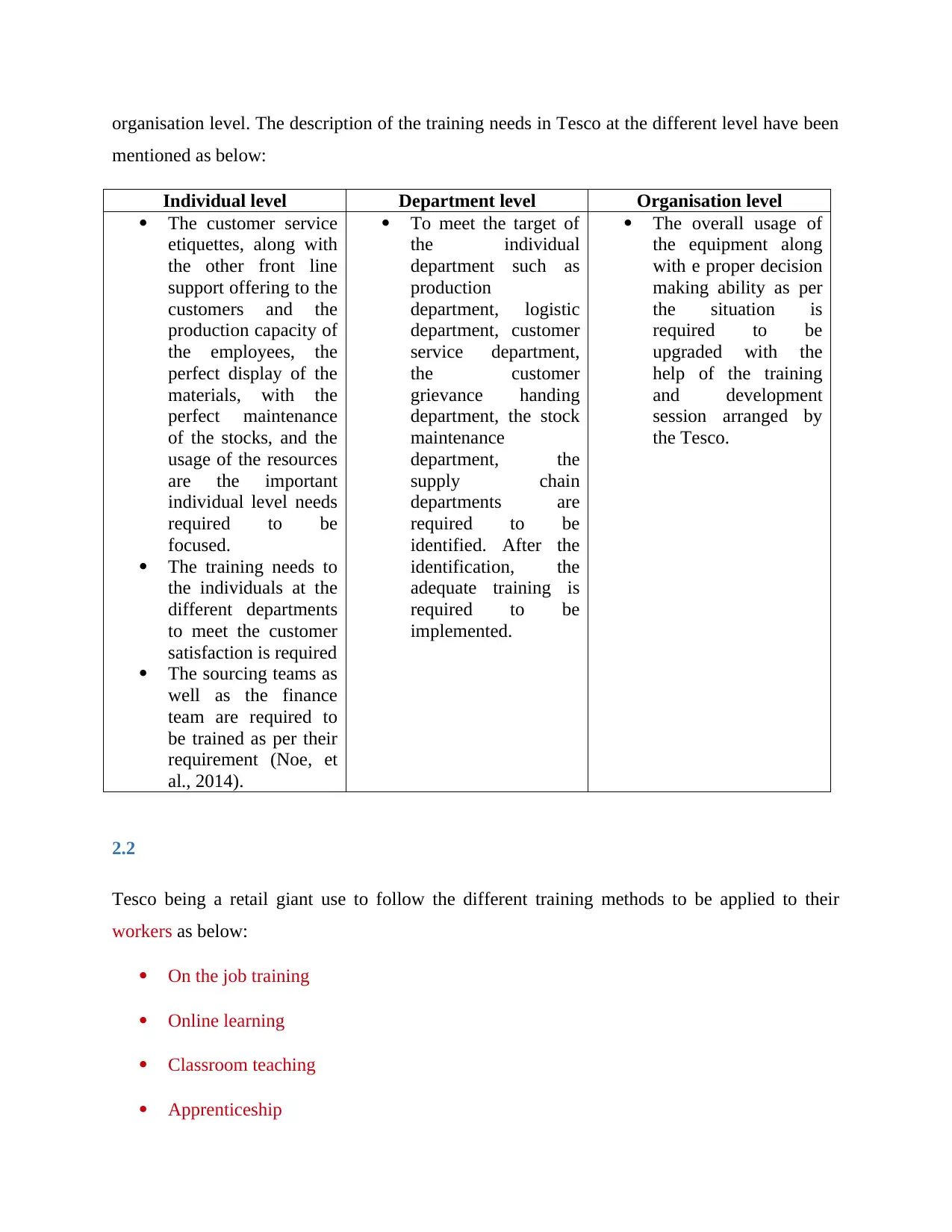
organisation level. The description of the training needs in Tesco at the different level have been
mentioned as below:
Individual level Department level Organisation level
The customer service
etiquettes, along with
the other front line
support offering to the
customers and the
production capacity of
the employees, the
perfect display of the
materials, with the
perfect maintenance
of the stocks, and the
usage of the resources
are the important
individual level needs
required to be
focused.
The training needs to
the individuals at the
different departments
to meet the customer
satisfaction is required
The sourcing teams as
well as the finance
team are required to
be trained as per their
requirement (Noe, et
al., 2014).
To meet the target of
the individual
department such as
production
department, logistic
department, customer
service department,
the customer
grievance handing
department, the stock
maintenance
department, the
supply chain
departments are
required to be
identified. After the
identification, the
adequate training is
required to be
implemented.
The overall usage of
the equipment along
with e proper decision
making ability as per
the situation is
required to be
upgraded with the
help of the training
and development
session arranged by
the Tesco.
2.2
Tesco being a retail giant use to follow the different training methods to be applied to their
workers as below:
On the job training
Online learning
Classroom teaching
Apprenticeship
mentioned as below:
Individual level Department level Organisation level
The customer service
etiquettes, along with
the other front line
support offering to the
customers and the
production capacity of
the employees, the
perfect display of the
materials, with the
perfect maintenance
of the stocks, and the
usage of the resources
are the important
individual level needs
required to be
focused.
The training needs to
the individuals at the
different departments
to meet the customer
satisfaction is required
The sourcing teams as
well as the finance
team are required to
be trained as per their
requirement (Noe, et
al., 2014).
To meet the target of
the individual
department such as
production
department, logistic
department, customer
service department,
the customer
grievance handing
department, the stock
maintenance
department, the
supply chain
departments are
required to be
identified. After the
identification, the
adequate training is
required to be
implemented.
The overall usage of
the equipment along
with e proper decision
making ability as per
the situation is
required to be
upgraded with the
help of the training
and development
session arranged by
the Tesco.
2.2
Tesco being a retail giant use to follow the different training methods to be applied to their
workers as below:
On the job training
Online learning
Classroom teaching
Apprenticeship
Secure Best Marks with AI Grader
Need help grading? Try our AI Grader for instant feedback on your assignments.
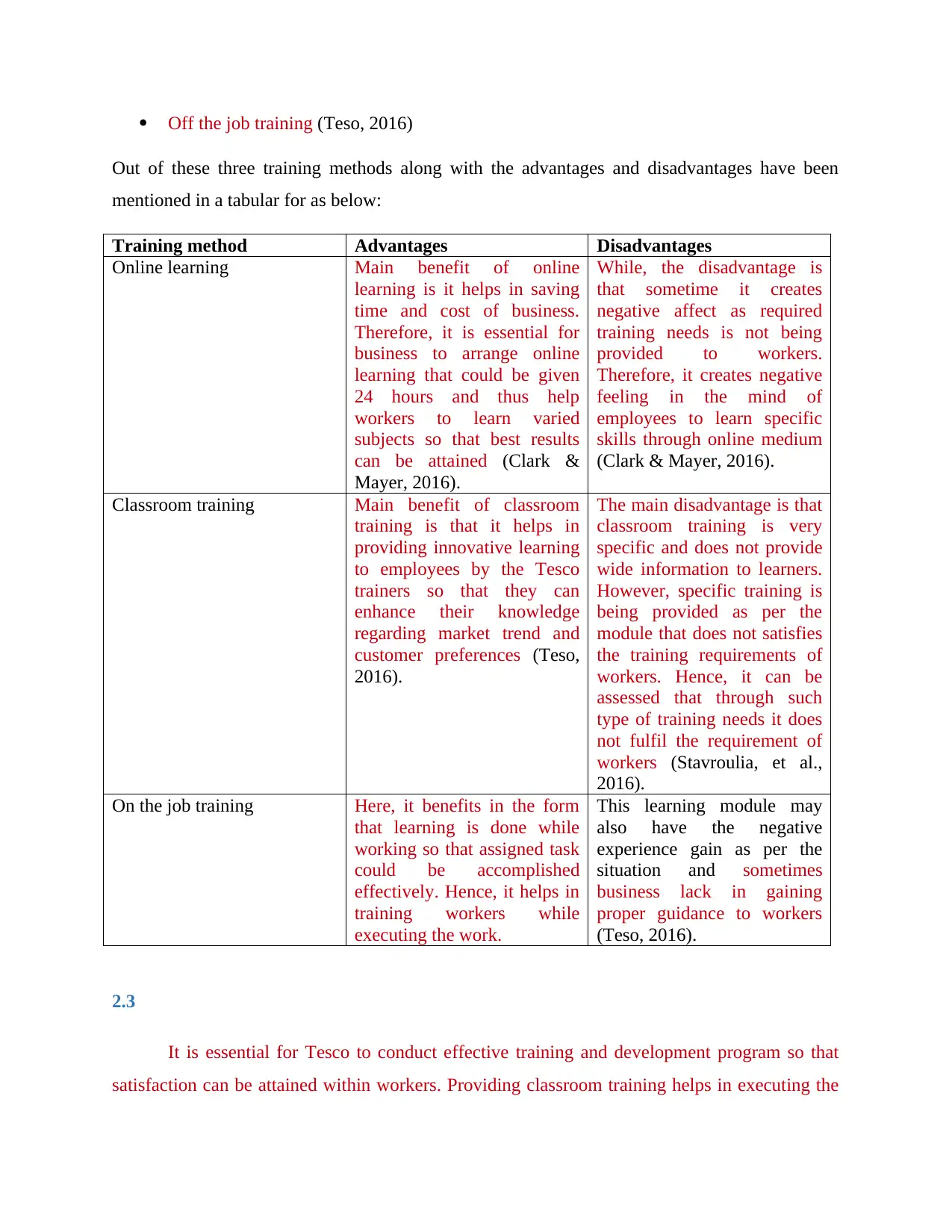
Off the job training (Teso, 2016)
Out of these three training methods along with the advantages and disadvantages have been
mentioned in a tabular for as below:
Training method Advantages Disadvantages
Online learning Main benefit of online
learning is it helps in saving
time and cost of business.
Therefore, it is essential for
business to arrange online
learning that could be given
24 hours and thus help
workers to learn varied
subjects so that best results
can be attained (Clark &
Mayer, 2016).
While, the disadvantage is
that sometime it creates
negative affect as required
training needs is not being
provided to workers.
Therefore, it creates negative
feeling in the mind of
employees to learn specific
skills through online medium
(Clark & Mayer, 2016).
Classroom training Main benefit of classroom
training is that it helps in
providing innovative learning
to employees by the Tesco
trainers so that they can
enhance their knowledge
regarding market trend and
customer preferences (Teso,
2016).
The main disadvantage is that
classroom training is very
specific and does not provide
wide information to learners.
However, specific training is
being provided as per the
module that does not satisfies
the training requirements of
workers. Hence, it can be
assessed that through such
type of training needs it does
not fulfil the requirement of
workers (Stavroulia, et al.,
2016).
On the job training Here, it benefits in the form
that learning is done while
working so that assigned task
could be accomplished
effectively. Hence, it helps in
training workers while
executing the work.
This learning module may
also have the negative
experience gain as per the
situation and sometimes
business lack in gaining
proper guidance to workers
(Teso, 2016).
2.3
It is essential for Tesco to conduct effective training and development program so that
satisfaction can be attained within workers. Providing classroom training helps in executing the
Out of these three training methods along with the advantages and disadvantages have been
mentioned in a tabular for as below:
Training method Advantages Disadvantages
Online learning Main benefit of online
learning is it helps in saving
time and cost of business.
Therefore, it is essential for
business to arrange online
learning that could be given
24 hours and thus help
workers to learn varied
subjects so that best results
can be attained (Clark &
Mayer, 2016).
While, the disadvantage is
that sometime it creates
negative affect as required
training needs is not being
provided to workers.
Therefore, it creates negative
feeling in the mind of
employees to learn specific
skills through online medium
(Clark & Mayer, 2016).
Classroom training Main benefit of classroom
training is that it helps in
providing innovative learning
to employees by the Tesco
trainers so that they can
enhance their knowledge
regarding market trend and
customer preferences (Teso,
2016).
The main disadvantage is that
classroom training is very
specific and does not provide
wide information to learners.
However, specific training is
being provided as per the
module that does not satisfies
the training requirements of
workers. Hence, it can be
assessed that through such
type of training needs it does
not fulfil the requirement of
workers (Stavroulia, et al.,
2016).
On the job training Here, it benefits in the form
that learning is done while
working so that assigned task
could be accomplished
effectively. Hence, it helps in
training workers while
executing the work.
This learning module may
also have the negative
experience gain as per the
situation and sometimes
business lack in gaining
proper guidance to workers
(Teso, 2016).
2.3
It is essential for Tesco to conduct effective training and development program so that
satisfaction can be attained within workers. Providing classroom training helps in executing the
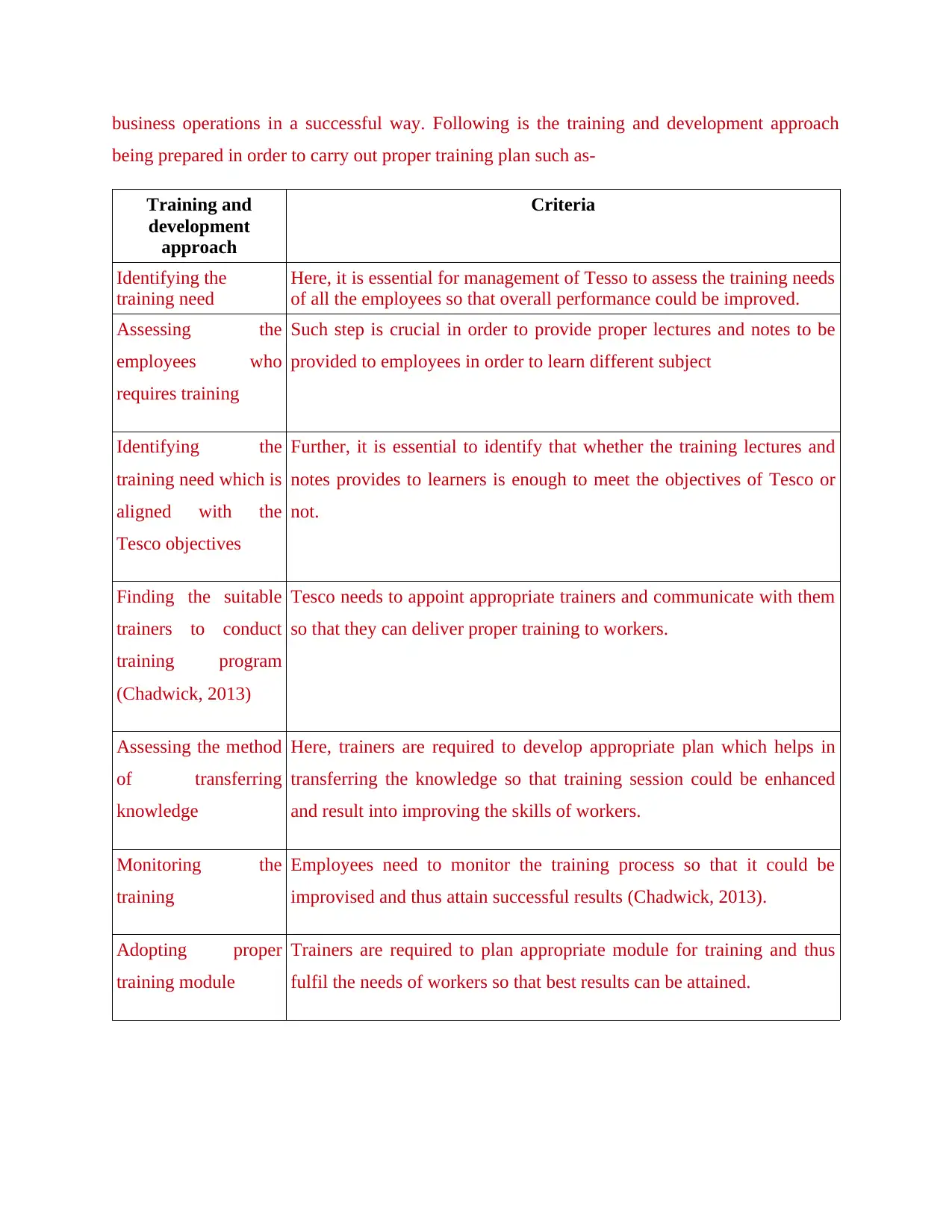
business operations in a successful way. Following is the training and development approach
being prepared in order to carry out proper training plan such as-
Training and
development
approach
Criteria
Identifying the
training need
Here, it is essential for management of Tesso to assess the training needs
of all the employees so that overall performance could be improved.
Assessing the
employees who
requires training
Such step is crucial in order to provide proper lectures and notes to be
provided to employees in order to learn different subject
Identifying the
training need which is
aligned with the
Tesco objectives
Further, it is essential to identify that whether the training lectures and
notes provides to learners is enough to meet the objectives of Tesco or
not.
Finding the suitable
trainers to conduct
training program
(Chadwick, 2013)
Tesco needs to appoint appropriate trainers and communicate with them
so that they can deliver proper training to workers.
Assessing the method
of transferring
knowledge
Here, trainers are required to develop appropriate plan which helps in
transferring the knowledge so that training session could be enhanced
and result into improving the skills of workers.
Monitoring the
training
Employees need to monitor the training process so that it could be
improvised and thus attain successful results (Chadwick, 2013).
Adopting proper
training module
Trainers are required to plan appropriate module for training and thus
fulfil the needs of workers so that best results can be attained.
being prepared in order to carry out proper training plan such as-
Training and
development
approach
Criteria
Identifying the
training need
Here, it is essential for management of Tesso to assess the training needs
of all the employees so that overall performance could be improved.
Assessing the
employees who
requires training
Such step is crucial in order to provide proper lectures and notes to be
provided to employees in order to learn different subject
Identifying the
training need which is
aligned with the
Tesco objectives
Further, it is essential to identify that whether the training lectures and
notes provides to learners is enough to meet the objectives of Tesco or
not.
Finding the suitable
trainers to conduct
training program
(Chadwick, 2013)
Tesco needs to appoint appropriate trainers and communicate with them
so that they can deliver proper training to workers.
Assessing the method
of transferring
knowledge
Here, trainers are required to develop appropriate plan which helps in
transferring the knowledge so that training session could be enhanced
and result into improving the skills of workers.
Monitoring the
training
Employees need to monitor the training process so that it could be
improvised and thus attain successful results (Chadwick, 2013).
Adopting proper
training module
Trainers are required to plan appropriate module for training and thus
fulfil the needs of workers so that best results can be attained.
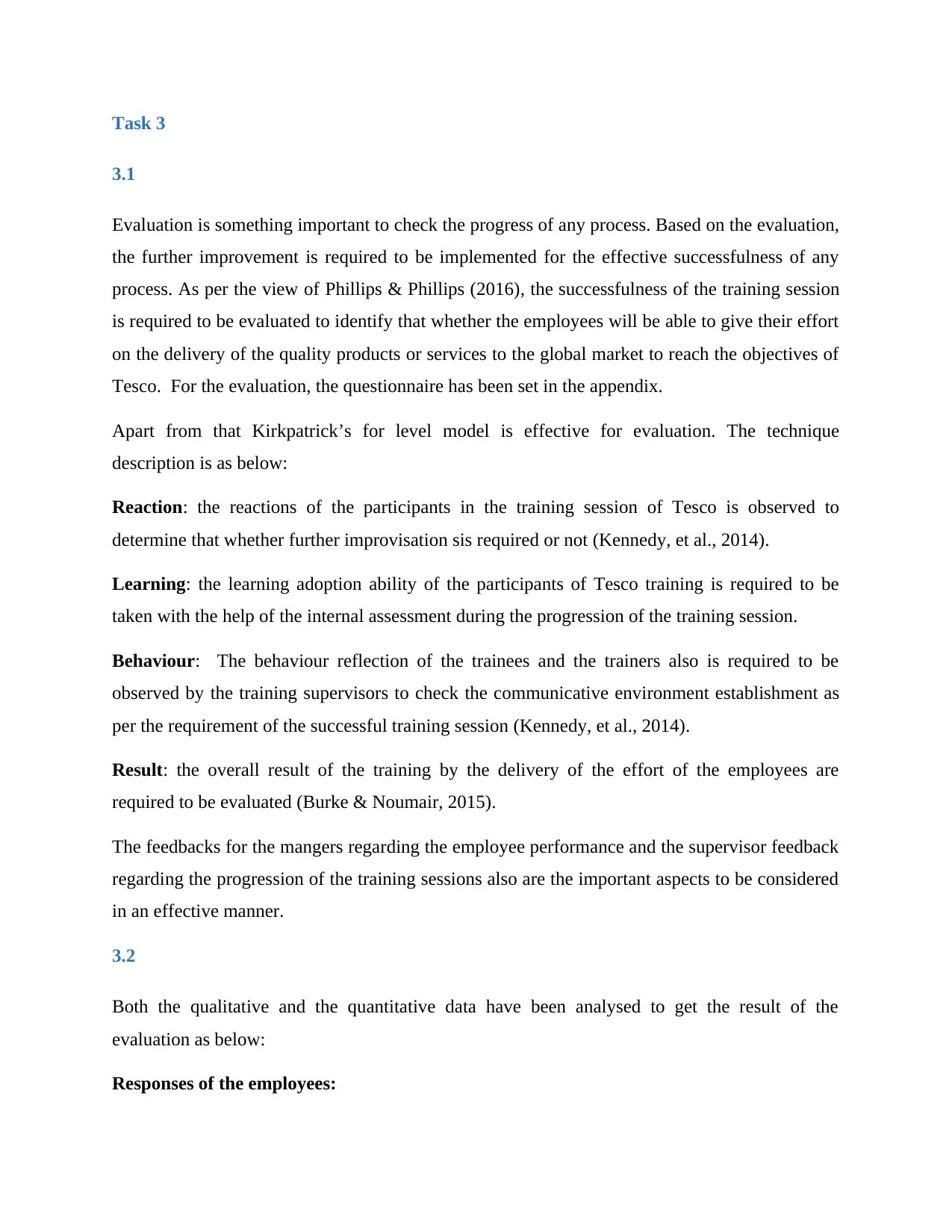
Task 3
3.1
Evaluation is something important to check the progress of any process. Based on the evaluation,
the further improvement is required to be implemented for the effective successfulness of any
process. As per the view of Phillips & Phillips (2016), the successfulness of the training session
is required to be evaluated to identify that whether the employees will be able to give their effort
on the delivery of the quality products or services to the global market to reach the objectives of
Tesco. For the evaluation, the questionnaire has been set in the appendix.
Apart from that Kirkpatrick’s for level model is effective for evaluation. The technique
description is as below:
Reaction: the reactions of the participants in the training session of Tesco is observed to
determine that whether further improvisation sis required or not (Kennedy, et al., 2014).
Learning: the learning adoption ability of the participants of Tesco training is required to be
taken with the help of the internal assessment during the progression of the training session.
Behaviour: The behaviour reflection of the trainees and the trainers also is required to be
observed by the training supervisors to check the communicative environment establishment as
per the requirement of the successful training session (Kennedy, et al., 2014).
Result: the overall result of the training by the delivery of the effort of the employees are
required to be evaluated (Burke & Noumair, 2015).
The feedbacks for the mangers regarding the employee performance and the supervisor feedback
regarding the progression of the training sessions also are the important aspects to be considered
in an effective manner.
3.2
Both the qualitative and the quantitative data have been analysed to get the result of the
evaluation as below:
Responses of the employees:
3.1
Evaluation is something important to check the progress of any process. Based on the evaluation,
the further improvement is required to be implemented for the effective successfulness of any
process. As per the view of Phillips & Phillips (2016), the successfulness of the training session
is required to be evaluated to identify that whether the employees will be able to give their effort
on the delivery of the quality products or services to the global market to reach the objectives of
Tesco. For the evaluation, the questionnaire has been set in the appendix.
Apart from that Kirkpatrick’s for level model is effective for evaluation. The technique
description is as below:
Reaction: the reactions of the participants in the training session of Tesco is observed to
determine that whether further improvisation sis required or not (Kennedy, et al., 2014).
Learning: the learning adoption ability of the participants of Tesco training is required to be
taken with the help of the internal assessment during the progression of the training session.
Behaviour: The behaviour reflection of the trainees and the trainers also is required to be
observed by the training supervisors to check the communicative environment establishment as
per the requirement of the successful training session (Kennedy, et al., 2014).
Result: the overall result of the training by the delivery of the effort of the employees are
required to be evaluated (Burke & Noumair, 2015).
The feedbacks for the mangers regarding the employee performance and the supervisor feedback
regarding the progression of the training sessions also are the important aspects to be considered
in an effective manner.
3.2
Both the qualitative and the quantitative data have been analysed to get the result of the
evaluation as below:
Responses of the employees:
Paraphrase This Document
Need a fresh take? Get an instant paraphrase of this document with our AI Paraphraser
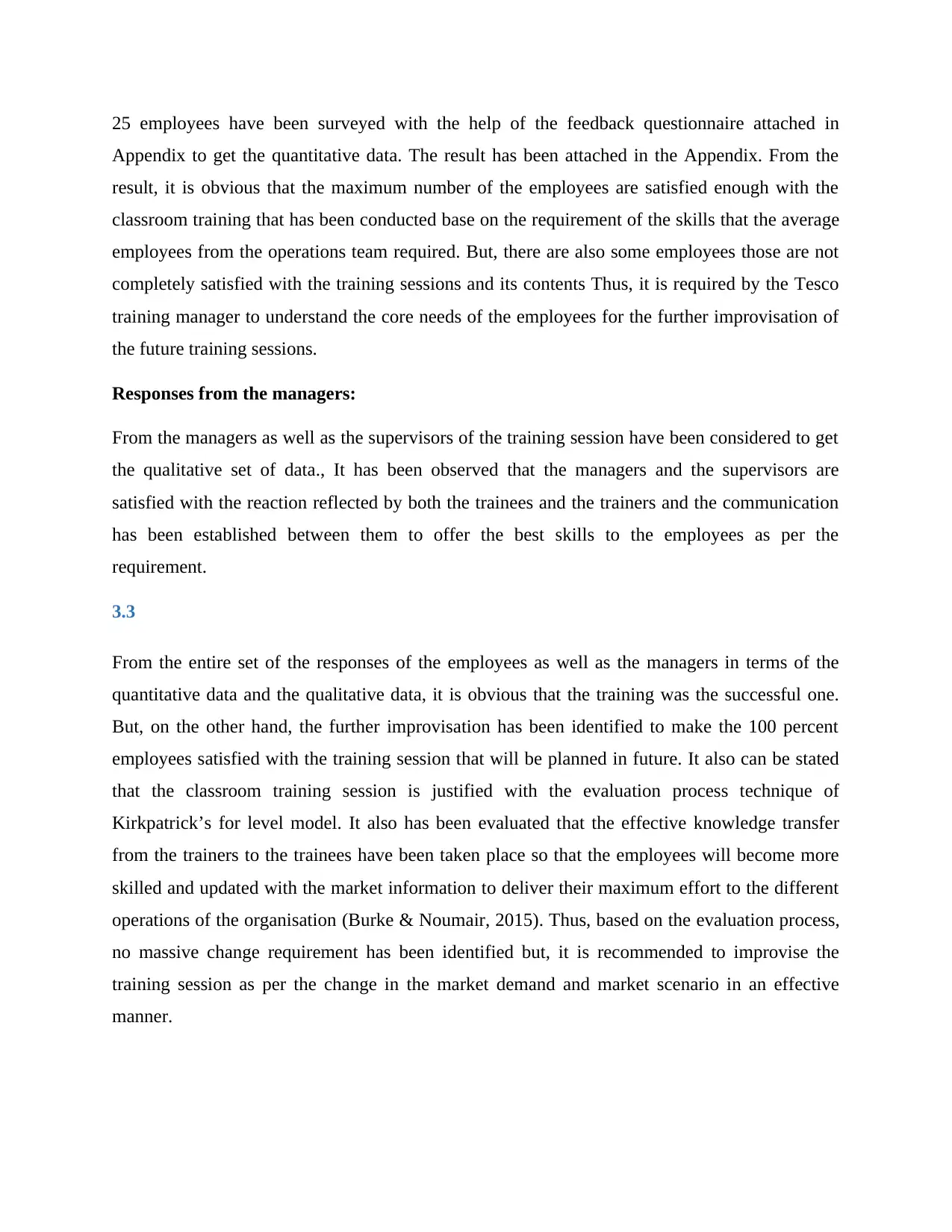
25 employees have been surveyed with the help of the feedback questionnaire attached in
Appendix to get the quantitative data. The result has been attached in the Appendix. From the
result, it is obvious that the maximum number of the employees are satisfied enough with the
classroom training that has been conducted base on the requirement of the skills that the average
employees from the operations team required. But, there are also some employees those are not
completely satisfied with the training sessions and its contents Thus, it is required by the Tesco
training manager to understand the core needs of the employees for the further improvisation of
the future training sessions.
Responses from the managers:
From the managers as well as the supervisors of the training session have been considered to get
the qualitative set of data., It has been observed that the managers and the supervisors are
satisfied with the reaction reflected by both the trainees and the trainers and the communication
has been established between them to offer the best skills to the employees as per the
requirement.
3.3
From the entire set of the responses of the employees as well as the managers in terms of the
quantitative data and the qualitative data, it is obvious that the training was the successful one.
But, on the other hand, the further improvisation has been identified to make the 100 percent
employees satisfied with the training session that will be planned in future. It also can be stated
that the classroom training session is justified with the evaluation process technique of
Kirkpatrick’s for level model. It also has been evaluated that the effective knowledge transfer
from the trainers to the trainees have been taken place so that the employees will become more
skilled and updated with the market information to deliver their maximum effort to the different
operations of the organisation (Burke & Noumair, 2015). Thus, based on the evaluation process,
no massive change requirement has been identified but, it is recommended to improvise the
training session as per the change in the market demand and market scenario in an effective
manner.
Appendix to get the quantitative data. The result has been attached in the Appendix. From the
result, it is obvious that the maximum number of the employees are satisfied enough with the
classroom training that has been conducted base on the requirement of the skills that the average
employees from the operations team required. But, there are also some employees those are not
completely satisfied with the training sessions and its contents Thus, it is required by the Tesco
training manager to understand the core needs of the employees for the further improvisation of
the future training sessions.
Responses from the managers:
From the managers as well as the supervisors of the training session have been considered to get
the qualitative set of data., It has been observed that the managers and the supervisors are
satisfied with the reaction reflected by both the trainees and the trainers and the communication
has been established between them to offer the best skills to the employees as per the
requirement.
3.3
From the entire set of the responses of the employees as well as the managers in terms of the
quantitative data and the qualitative data, it is obvious that the training was the successful one.
But, on the other hand, the further improvisation has been identified to make the 100 percent
employees satisfied with the training session that will be planned in future. It also can be stated
that the classroom training session is justified with the evaluation process technique of
Kirkpatrick’s for level model. It also has been evaluated that the effective knowledge transfer
from the trainers to the trainees have been taken place so that the employees will become more
skilled and updated with the market information to deliver their maximum effort to the different
operations of the organisation (Burke & Noumair, 2015). Thus, based on the evaluation process,
no massive change requirement has been identified but, it is recommended to improvise the
training session as per the change in the market demand and market scenario in an effective
manner.
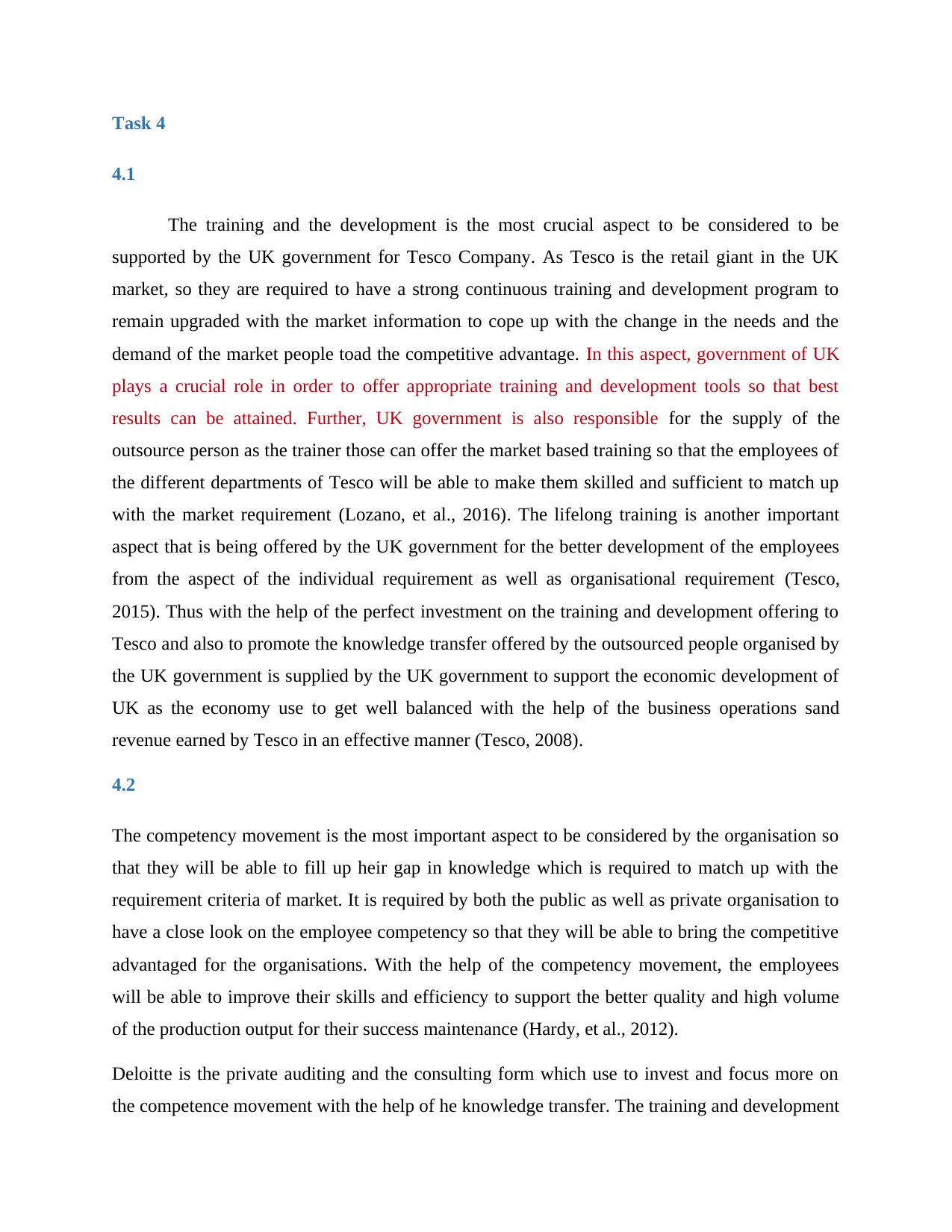
Task 4
4.1
The training and the development is the most crucial aspect to be considered to be
supported by the UK government for Tesco Company. As Tesco is the retail giant in the UK
market, so they are required to have a strong continuous training and development program to
remain upgraded with the market information to cope up with the change in the needs and the
demand of the market people toad the competitive advantage. In this aspect, government of UK
plays a crucial role in order to offer appropriate training and development tools so that best
results can be attained. Further, UK government is also responsible for the supply of the
outsource person as the trainer those can offer the market based training so that the employees of
the different departments of Tesco will be able to make them skilled and sufficient to match up
with the market requirement (Lozano, et al., 2016). The lifelong training is another important
aspect that is being offered by the UK government for the better development of the employees
from the aspect of the individual requirement as well as organisational requirement (Tesco,
2015). Thus with the help of the perfect investment on the training and development offering to
Tesco and also to promote the knowledge transfer offered by the outsourced people organised by
the UK government is supplied by the UK government to support the economic development of
UK as the economy use to get well balanced with the help of the business operations sand
revenue earned by Tesco in an effective manner (Tesco, 2008).
4.2
The competency movement is the most important aspect to be considered by the organisation so
that they will be able to fill up heir gap in knowledge which is required to match up with the
requirement criteria of market. It is required by both the public as well as private organisation to
have a close look on the employee competency so that they will be able to bring the competitive
advantaged for the organisations. With the help of the competency movement, the employees
will be able to improve their skills and efficiency to support the better quality and high volume
of the production output for their success maintenance (Hardy, et al., 2012).
Deloitte is the private auditing and the consulting form which use to invest and focus more on
the competence movement with the help of he knowledge transfer. The training and development
4.1
The training and the development is the most crucial aspect to be considered to be
supported by the UK government for Tesco Company. As Tesco is the retail giant in the UK
market, so they are required to have a strong continuous training and development program to
remain upgraded with the market information to cope up with the change in the needs and the
demand of the market people toad the competitive advantage. In this aspect, government of UK
plays a crucial role in order to offer appropriate training and development tools so that best
results can be attained. Further, UK government is also responsible for the supply of the
outsource person as the trainer those can offer the market based training so that the employees of
the different departments of Tesco will be able to make them skilled and sufficient to match up
with the market requirement (Lozano, et al., 2016). The lifelong training is another important
aspect that is being offered by the UK government for the better development of the employees
from the aspect of the individual requirement as well as organisational requirement (Tesco,
2015). Thus with the help of the perfect investment on the training and development offering to
Tesco and also to promote the knowledge transfer offered by the outsourced people organised by
the UK government is supplied by the UK government to support the economic development of
UK as the economy use to get well balanced with the help of the business operations sand
revenue earned by Tesco in an effective manner (Tesco, 2008).
4.2
The competency movement is the most important aspect to be considered by the organisation so
that they will be able to fill up heir gap in knowledge which is required to match up with the
requirement criteria of market. It is required by both the public as well as private organisation to
have a close look on the employee competency so that they will be able to bring the competitive
advantaged for the organisations. With the help of the competency movement, the employees
will be able to improve their skills and efficiency to support the better quality and high volume
of the production output for their success maintenance (Hardy, et al., 2012).
Deloitte is the private auditing and the consulting form which use to invest and focus more on
the competence movement with the help of he knowledge transfer. The training and development
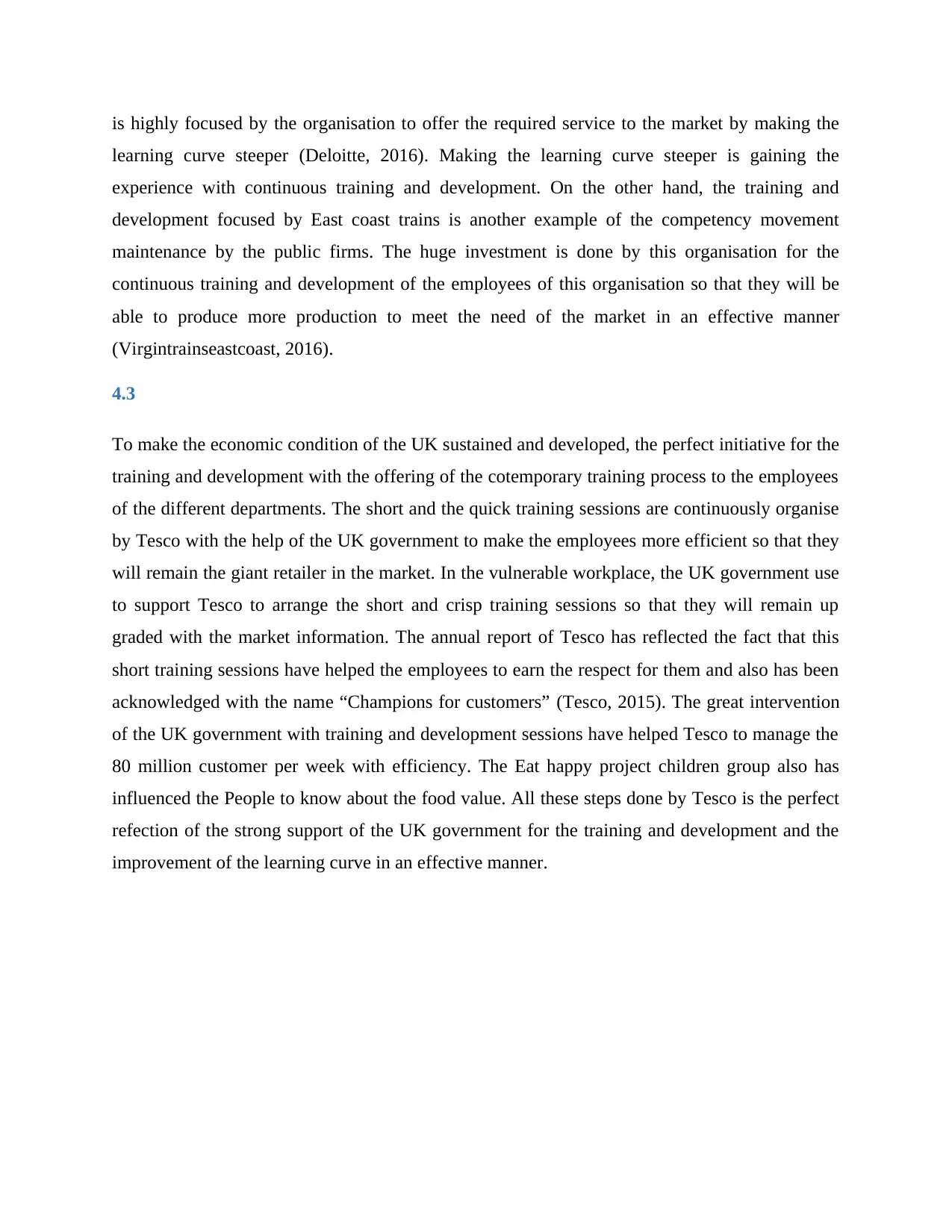
is highly focused by the organisation to offer the required service to the market by making the
learning curve steeper (Deloitte, 2016). Making the learning curve steeper is gaining the
experience with continuous training and development. On the other hand, the training and
development focused by East coast trains is another example of the competency movement
maintenance by the public firms. The huge investment is done by this organisation for the
continuous training and development of the employees of this organisation so that they will be
able to produce more production to meet the need of the market in an effective manner
(Virgintrainseastcoast, 2016).
4.3
To make the economic condition of the UK sustained and developed, the perfect initiative for the
training and development with the offering of the cotemporary training process to the employees
of the different departments. The short and the quick training sessions are continuously organise
by Tesco with the help of the UK government to make the employees more efficient so that they
will remain the giant retailer in the market. In the vulnerable workplace, the UK government use
to support Tesco to arrange the short and crisp training sessions so that they will remain up
graded with the market information. The annual report of Tesco has reflected the fact that this
short training sessions have helped the employees to earn the respect for them and also has been
acknowledged with the name “Champions for customers” (Tesco, 2015). The great intervention
of the UK government with training and development sessions have helped Tesco to manage the
80 million customer per week with efficiency. The Eat happy project children group also has
influenced the People to know about the food value. All these steps done by Tesco is the perfect
refection of the strong support of the UK government for the training and development and the
improvement of the learning curve in an effective manner.
learning curve steeper (Deloitte, 2016). Making the learning curve steeper is gaining the
experience with continuous training and development. On the other hand, the training and
development focused by East coast trains is another example of the competency movement
maintenance by the public firms. The huge investment is done by this organisation for the
continuous training and development of the employees of this organisation so that they will be
able to produce more production to meet the need of the market in an effective manner
(Virgintrainseastcoast, 2016).
4.3
To make the economic condition of the UK sustained and developed, the perfect initiative for the
training and development with the offering of the cotemporary training process to the employees
of the different departments. The short and the quick training sessions are continuously organise
by Tesco with the help of the UK government to make the employees more efficient so that they
will remain the giant retailer in the market. In the vulnerable workplace, the UK government use
to support Tesco to arrange the short and crisp training sessions so that they will remain up
graded with the market information. The annual report of Tesco has reflected the fact that this
short training sessions have helped the employees to earn the respect for them and also has been
acknowledged with the name “Champions for customers” (Tesco, 2015). The great intervention
of the UK government with training and development sessions have helped Tesco to manage the
80 million customer per week with efficiency. The Eat happy project children group also has
influenced the People to know about the food value. All these steps done by Tesco is the perfect
refection of the strong support of the UK government for the training and development and the
improvement of the learning curve in an effective manner.
Secure Best Marks with AI Grader
Need help grading? Try our AI Grader for instant feedback on your assignments.
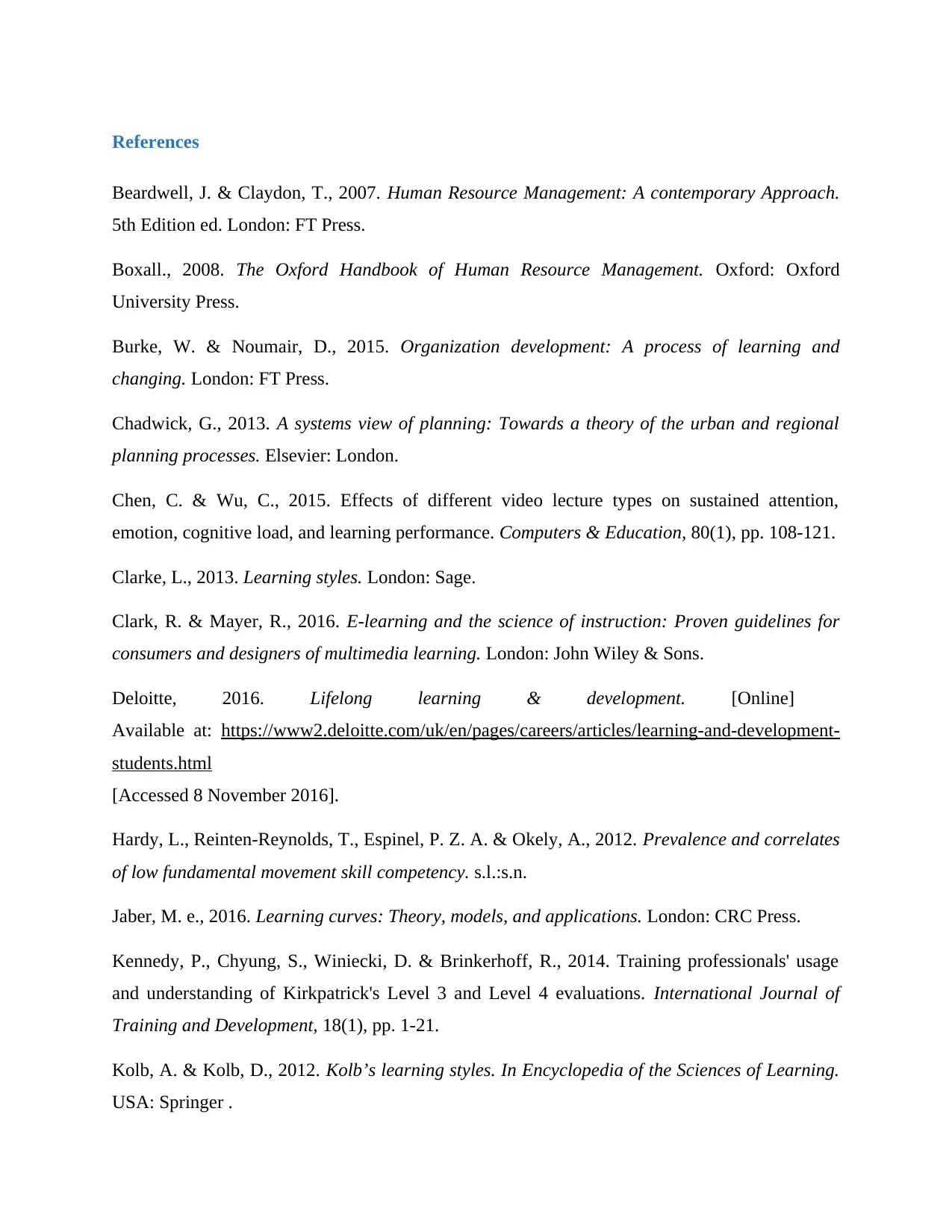
References
Beardwell, J. & Claydon, T., 2007. Human Resource Management: A contemporary Approach.
5th Edition ed. London: FT Press.
Boxall., 2008. The Oxford Handbook of Human Resource Management. Oxford: Oxford
University Press.
Burke, W. & Noumair, D., 2015. Organization development: A process of learning and
changing. London: FT Press.
Chadwick, G., 2013. A systems view of planning: Towards a theory of the urban and regional
planning processes. Elsevier: London.
Chen, C. & Wu, C., 2015. Effects of different video lecture types on sustained attention,
emotion, cognitive load, and learning performance. Computers & Education, 80(1), pp. 108-121.
Clarke, L., 2013. Learning styles. London: Sage.
Clark, R. & Mayer, R., 2016. E-learning and the science of instruction: Proven guidelines for
consumers and designers of multimedia learning. London: John Wiley & Sons.
Deloitte, 2016. Lifelong learning & development. [Online]
Available at: https://www2.deloitte.com/uk/en/pages/careers/articles/learning-and-development-
students.html
[Accessed 8 November 2016].
Hardy, L., Reinten-Reynolds, T., Espinel, P. Z. A. & Okely, A., 2012. Prevalence and correlates
of low fundamental movement skill competency. s.l.:s.n.
Jaber, M. e., 2016. Learning curves: Theory, models, and applications. London: CRC Press.
Kennedy, P., Chyung, S., Winiecki, D. & Brinkerhoff, R., 2014. Training professionals' usage
and understanding of Kirkpatrick's Level 3 and Level 4 evaluations. International Journal of
Training and Development, 18(1), pp. 1-21.
Kolb, A. & Kolb, D., 2012. Kolb’s learning styles. In Encyclopedia of the Sciences of Learning.
USA: Springer .
Beardwell, J. & Claydon, T., 2007. Human Resource Management: A contemporary Approach.
5th Edition ed. London: FT Press.
Boxall., 2008. The Oxford Handbook of Human Resource Management. Oxford: Oxford
University Press.
Burke, W. & Noumair, D., 2015. Organization development: A process of learning and
changing. London: FT Press.
Chadwick, G., 2013. A systems view of planning: Towards a theory of the urban and regional
planning processes. Elsevier: London.
Chen, C. & Wu, C., 2015. Effects of different video lecture types on sustained attention,
emotion, cognitive load, and learning performance. Computers & Education, 80(1), pp. 108-121.
Clarke, L., 2013. Learning styles. London: Sage.
Clark, R. & Mayer, R., 2016. E-learning and the science of instruction: Proven guidelines for
consumers and designers of multimedia learning. London: John Wiley & Sons.
Deloitte, 2016. Lifelong learning & development. [Online]
Available at: https://www2.deloitte.com/uk/en/pages/careers/articles/learning-and-development-
students.html
[Accessed 8 November 2016].
Hardy, L., Reinten-Reynolds, T., Espinel, P. Z. A. & Okely, A., 2012. Prevalence and correlates
of low fundamental movement skill competency. s.l.:s.n.
Jaber, M. e., 2016. Learning curves: Theory, models, and applications. London: CRC Press.
Kennedy, P., Chyung, S., Winiecki, D. & Brinkerhoff, R., 2014. Training professionals' usage
and understanding of Kirkpatrick's Level 3 and Level 4 evaluations. International Journal of
Training and Development, 18(1), pp. 1-21.
Kolb, A. & Kolb, D., 2012. Kolb’s learning styles. In Encyclopedia of the Sciences of Learning.
USA: Springer .
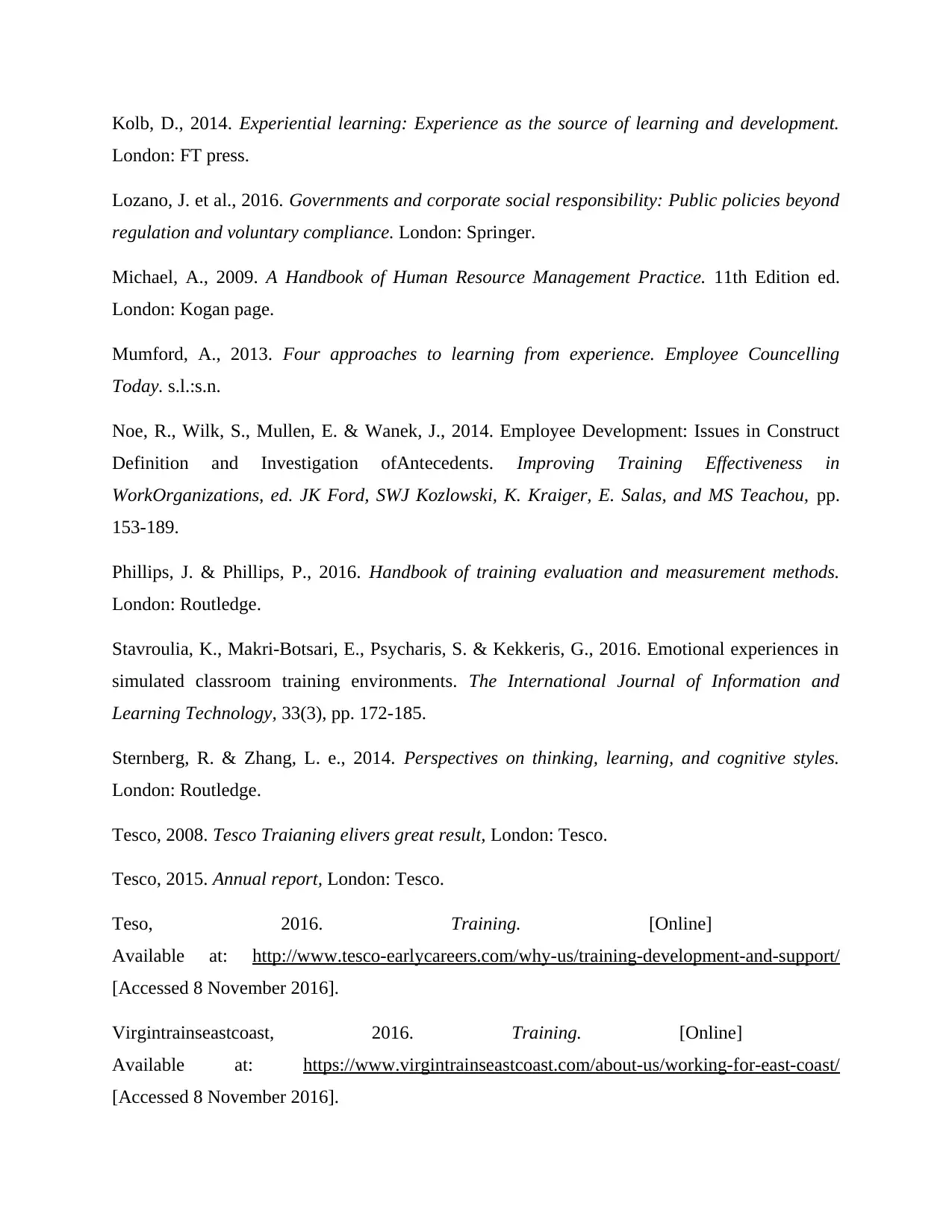
Kolb, D., 2014. Experiential learning: Experience as the source of learning and development.
London: FT press.
Lozano, J. et al., 2016. Governments and corporate social responsibility: Public policies beyond
regulation and voluntary compliance. London: Springer.
Michael, A., 2009. A Handbook of Human Resource Management Practice. 11th Edition ed.
London: Kogan page.
Mumford, A., 2013. Four approaches to learning from experience. Employee Councelling
Today. s.l.:s.n.
Noe, R., Wilk, S., Mullen, E. & Wanek, J., 2014. Employee Development: Issues in Construct
Definition and Investigation ofAntecedents. Improving Training Effectiveness in
WorkOrganizations, ed. JK Ford, SWJ Kozlowski, K. Kraiger, E. Salas, and MS Teachou, pp.
153-189.
Phillips, J. & Phillips, P., 2016. Handbook of training evaluation and measurement methods.
London: Routledge.
Stavroulia, K., Makri-Botsari, E., Psycharis, S. & Kekkeris, G., 2016. Emotional experiences in
simulated classroom training environments. The International Journal of Information and
Learning Technology, 33(3), pp. 172-185.
Sternberg, R. & Zhang, L. e., 2014. Perspectives on thinking, learning, and cognitive styles.
London: Routledge.
Tesco, 2008. Tesco Traianing elivers great result, London: Tesco.
Tesco, 2015. Annual report, London: Tesco.
Teso, 2016. Training. [Online]
Available at: http://www.tesco-earlycareers.com/why-us/training-development-and-support/
[Accessed 8 November 2016].
Virgintrainseastcoast, 2016. Training. [Online]
Available at: https://www.virgintrainseastcoast.com/about-us/working-for-east-coast/
[Accessed 8 November 2016].
London: FT press.
Lozano, J. et al., 2016. Governments and corporate social responsibility: Public policies beyond
regulation and voluntary compliance. London: Springer.
Michael, A., 2009. A Handbook of Human Resource Management Practice. 11th Edition ed.
London: Kogan page.
Mumford, A., 2013. Four approaches to learning from experience. Employee Councelling
Today. s.l.:s.n.
Noe, R., Wilk, S., Mullen, E. & Wanek, J., 2014. Employee Development: Issues in Construct
Definition and Investigation ofAntecedents. Improving Training Effectiveness in
WorkOrganizations, ed. JK Ford, SWJ Kozlowski, K. Kraiger, E. Salas, and MS Teachou, pp.
153-189.
Phillips, J. & Phillips, P., 2016. Handbook of training evaluation and measurement methods.
London: Routledge.
Stavroulia, K., Makri-Botsari, E., Psycharis, S. & Kekkeris, G., 2016. Emotional experiences in
simulated classroom training environments. The International Journal of Information and
Learning Technology, 33(3), pp. 172-185.
Sternberg, R. & Zhang, L. e., 2014. Perspectives on thinking, learning, and cognitive styles.
London: Routledge.
Tesco, 2008. Tesco Traianing elivers great result, London: Tesco.
Tesco, 2015. Annual report, London: Tesco.
Teso, 2016. Training. [Online]
Available at: http://www.tesco-earlycareers.com/why-us/training-development-and-support/
[Accessed 8 November 2016].
Virgintrainseastcoast, 2016. Training. [Online]
Available at: https://www.virgintrainseastcoast.com/about-us/working-for-east-coast/
[Accessed 8 November 2016].

Paraphrase This Document
Need a fresh take? Get an instant paraphrase of this document with our AI Paraphraser
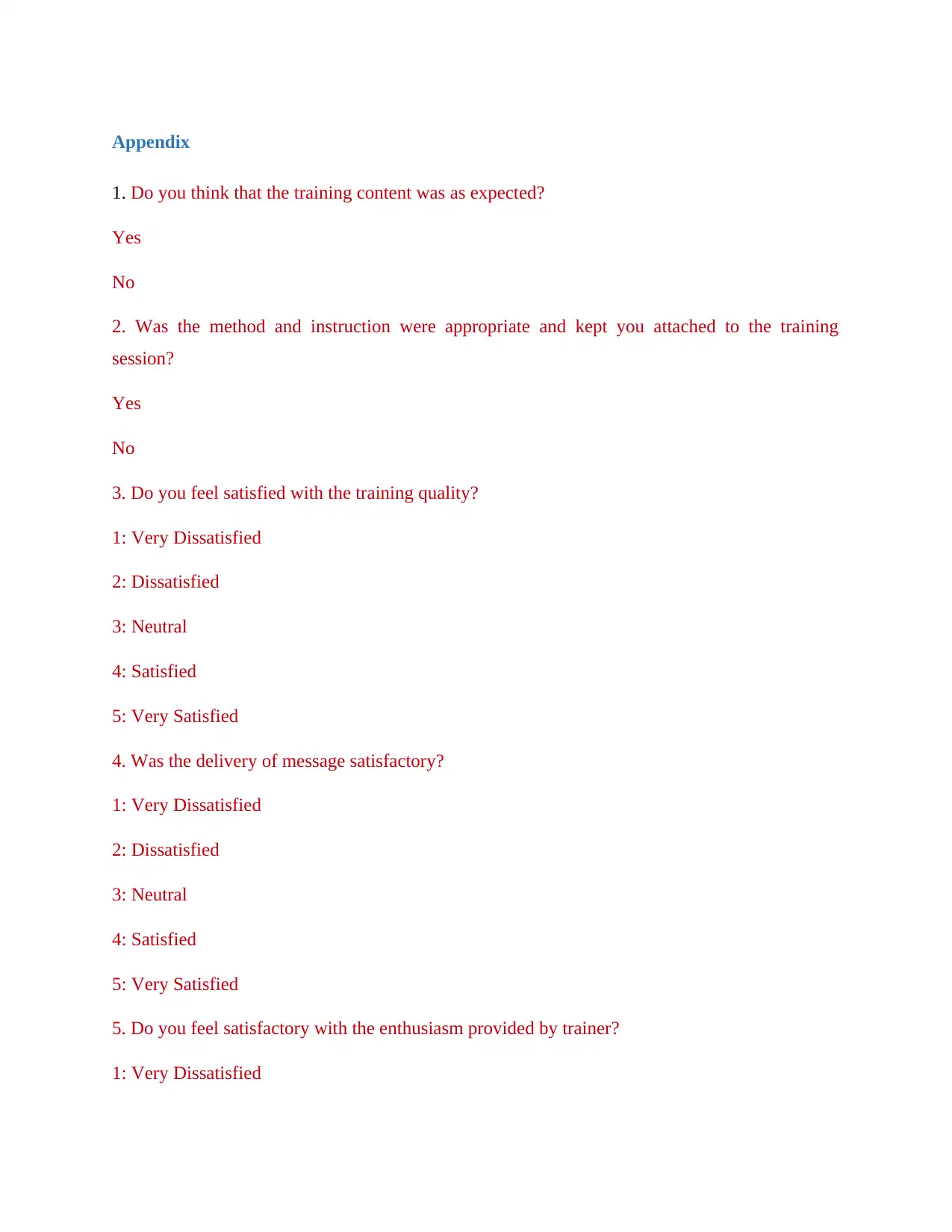
Appendix
1. Do you think that the training content was as expected?
Yes
No
2. Was the method and instruction were appropriate and kept you attached to the training
session?
Yes
No
3. Do you feel satisfied with the training quality?
1: Very Dissatisfied
2: Dissatisfied
3: Neutral
4: Satisfied
5: Very Satisfied
4. Was the delivery of message satisfactory?
1: Very Dissatisfied
2: Dissatisfied
3: Neutral
4: Satisfied
5: Very Satisfied
5. Do you feel satisfactory with the enthusiasm provided by trainer?
1: Very Dissatisfied
1. Do you think that the training content was as expected?
Yes
No
2. Was the method and instruction were appropriate and kept you attached to the training
session?
Yes
No
3. Do you feel satisfied with the training quality?
1: Very Dissatisfied
2: Dissatisfied
3: Neutral
4: Satisfied
5: Very Satisfied
4. Was the delivery of message satisfactory?
1: Very Dissatisfied
2: Dissatisfied
3: Neutral
4: Satisfied
5: Very Satisfied
5. Do you feel satisfactory with the enthusiasm provided by trainer?
1: Very Dissatisfied
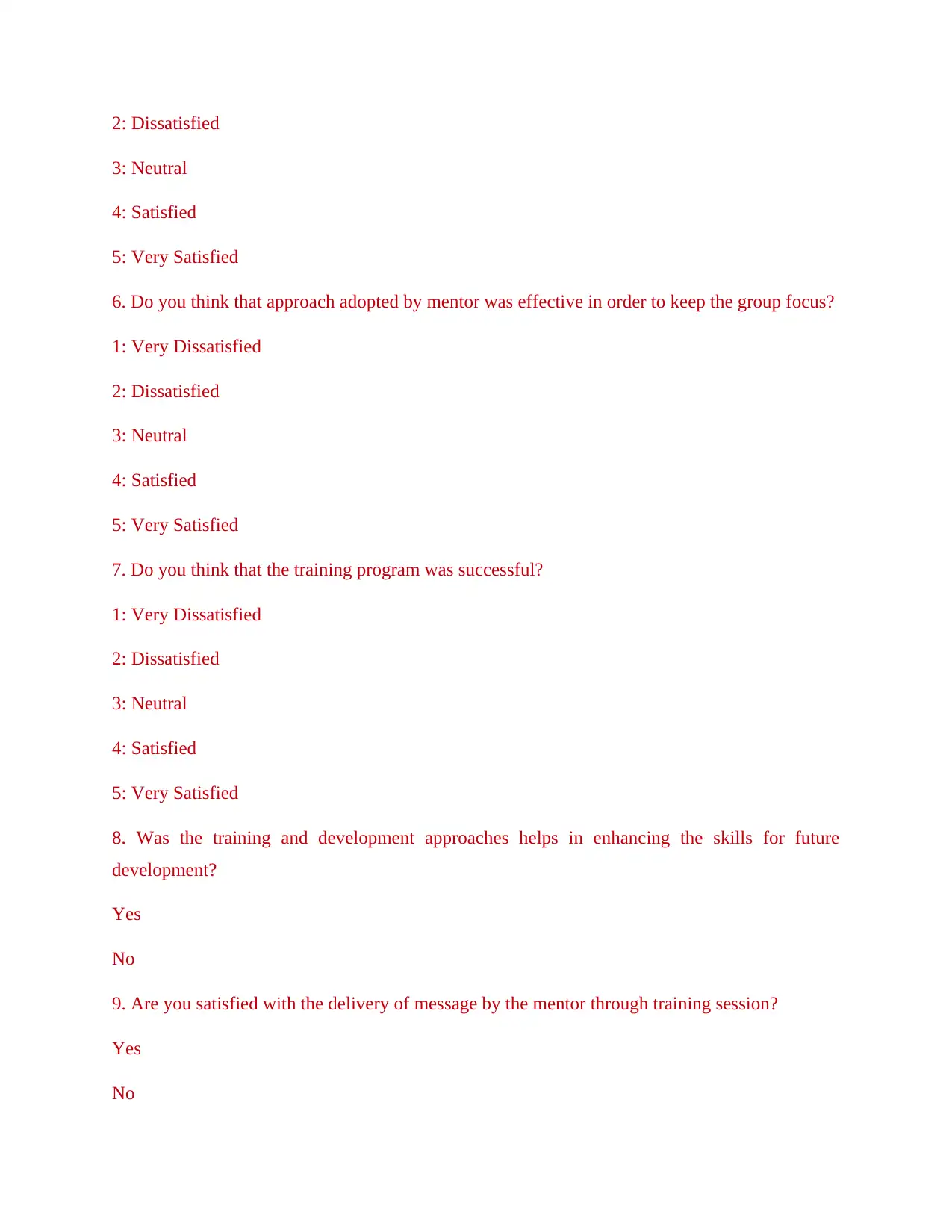
2: Dissatisfied
3: Neutral
4: Satisfied
5: Very Satisfied
6. Do you think that approach adopted by mentor was effective in order to keep the group focus?
1: Very Dissatisfied
2: Dissatisfied
3: Neutral
4: Satisfied
5: Very Satisfied
7. Do you think that the training program was successful?
1: Very Dissatisfied
2: Dissatisfied
3: Neutral
4: Satisfied
5: Very Satisfied
8. Was the training and development approaches helps in enhancing the skills for future
development?
Yes
No
9. Are you satisfied with the delivery of message by the mentor through training session?
Yes
No
3: Neutral
4: Satisfied
5: Very Satisfied
6. Do you think that approach adopted by mentor was effective in order to keep the group focus?
1: Very Dissatisfied
2: Dissatisfied
3: Neutral
4: Satisfied
5: Very Satisfied
7. Do you think that the training program was successful?
1: Very Dissatisfied
2: Dissatisfied
3: Neutral
4: Satisfied
5: Very Satisfied
8. Was the training and development approaches helps in enhancing the skills for future
development?
Yes
No
9. Are you satisfied with the delivery of message by the mentor through training session?
Yes
No
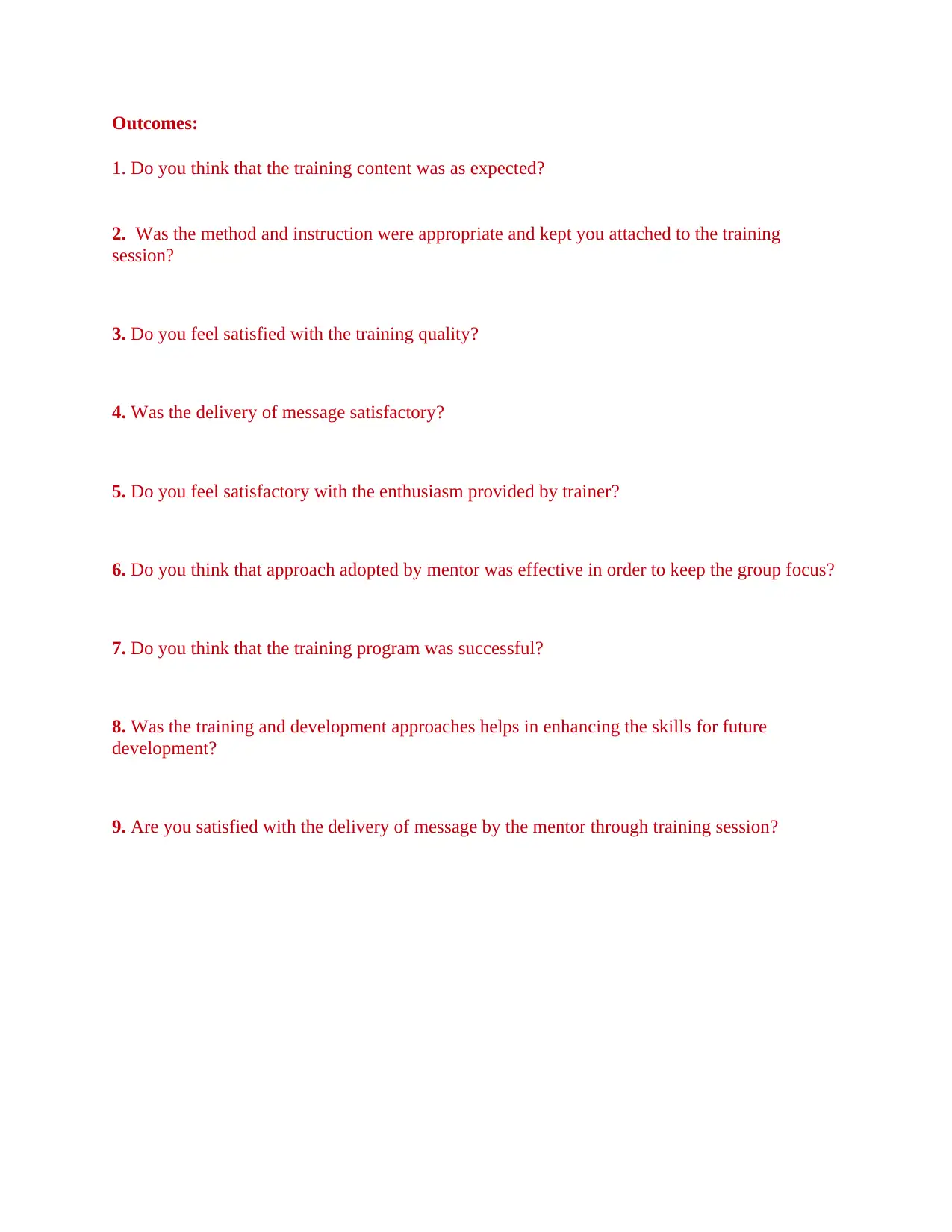
Outcomes:
1. Do you think that the training content was as expected?
2. Was the method and instruction were appropriate and kept you attached to the training
session?
3. Do you feel satisfied with the training quality?
4. Was the delivery of message satisfactory?
5. Do you feel satisfactory with the enthusiasm provided by trainer?
6. Do you think that approach adopted by mentor was effective in order to keep the group focus?
7. Do you think that the training program was successful?
8. Was the training and development approaches helps in enhancing the skills for future
development?
9. Are you satisfied with the delivery of message by the mentor through training session?
1. Do you think that the training content was as expected?
2. Was the method and instruction were appropriate and kept you attached to the training
session?
3. Do you feel satisfied with the training quality?
4. Was the delivery of message satisfactory?
5. Do you feel satisfactory with the enthusiasm provided by trainer?
6. Do you think that approach adopted by mentor was effective in order to keep the group focus?
7. Do you think that the training program was successful?
8. Was the training and development approaches helps in enhancing the skills for future
development?
9. Are you satisfied with the delivery of message by the mentor through training session?
1 out of 22
Related Documents
Your All-in-One AI-Powered Toolkit for Academic Success.
+13062052269
info@desklib.com
Available 24*7 on WhatsApp / Email
![[object Object]](/_next/static/media/star-bottom.7253800d.svg)
Unlock your academic potential
© 2024 | Zucol Services PVT LTD | All rights reserved.





